

Tour Flex vs. Stiff Flex: The Differences!
Choosing the appropriate shaft should be a priority when stocking your golf bag.
The right shaft will immensely improve your game and make you a better player.
When choosing the right shaft, there are many factors to consider. One of the most important factors is the flexibility of the shaft.
Generally, there are two different flex options: Tour flex and Stiff flex, each with unique advantages and disadvantages.
But how do they compare, and which is the better choice?
Follow along as we explore the differences between the Tour flex and Stiff flex to help you make a confident decision that will directly improve your game.
Tour and Stiff Flex are two shaft options designed to help players achieve maximum distance and accuracy with their swings.
They are built with high-quality materials, including steel or graphite, to enable substantial durability and performance.
Both come in different designs, lengths, and weights and cater to different target audiences, each accommodating different swing styles and preferences.
The Tour flex suits veteran golfers with a high swing speed.
This shaft offers low spin with extra distance but only guarantees a little control.
In contrast, the Stiff flex is ideal for players with a moderate swing speed of around 95mph.
While it is more flexible than the Tour flex, it is less durable. It’s an excellent option for mid-to-low handicappers, offering low spin and launch.
Generally, the Tour flex shaft is usually heavier and stiffer than the stiff flex shaft.
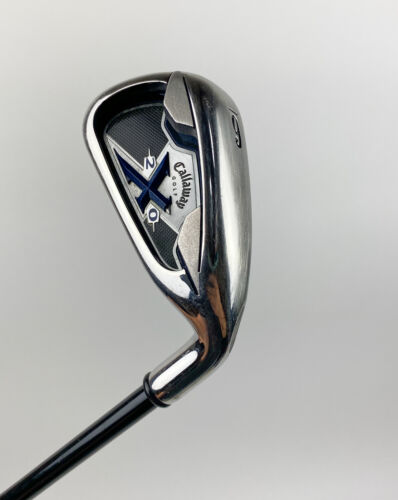
Features of Tour Flex
- An excellent option for fast driver speeds
- Relatively easy to manage flight and tempo
- Incredible distance
- Perfect for very fast swingers
- Limited Spin
- Heavier than the stiff flex
Features of Stiff Flex
- Better launch
- Great for high-swing speed providers.
- Lower spin rate
- Higher ball flight
- Simpler to control flight and height
- Less driving distance
Tour Flex vs. Stiff Flex: Differences
The Tour Flex and Stiff Flex differ in some varieties of ways.
Their main difference is their flexes during a swing, directly influencing the launch angle, ball flight, and feel.
The Tour flex is stiffer, making it great for players with lower handicaps. Conversely, the Stiff flex is more flexible, perfect for players with a mid-low handicap.
Let’s expound more on their differences using significant factors as follows:
Swing Speed
Swing speed is crucial in determining which flex option is right for you. Tour Flex shafts are designed for golfers with faster swing speeds.
They offer more flexibility, allowing the club to bend and whip through the ball, generating more clubhead speed.
Stiff Flex shafts are for golfers with slower swing speeds. They provide less flexibility and require more effort to generate clubhead speed.
The degree of flexibility in the shaft is the main difference between Tour flex and stiff flex.
Tour flex shafts have greater flex, which allows for more power and distance, but may sacrifice control and accuracy.
On the other hand, stiff flex shafts have less flex. They are better suited for golfers who prioritize control and precision over distance.
Distance is a critical factor in golf, and the shaft’s flex can significantly affect how far you hit the ball.
Tour flex will be your best option if you want extra distance. They are designed to maximize distance, while stiff flex shafts are geared more toward accuracy and control.
The golf ball spin rate also depends on the flex of the shaft.
Tour Flex shafts generally generate less spin, resulting in a flatter ball flight, which can help golfers achieve more distance.
Stiff Flex shafts produce more spin, providing more control over the ball’s trajectory, especially for golfers who tend to slice or hook the ball.
The launch angle is another essential factor when choosing a flex option.
Tour flex shafts typically produce a higher launch angle, which can help you achieve greater distance but may sacrifice accuracy.
On the other hand, stiff flex shafts have a lower launch angle, which can provide more control and precision.
The club’s feel is subjective and can vary depending on personal preference.
Generally, Stiff flex golf clubs provide more feel and feedback to the golfer during the swing, making them ideal for golfers who value control and precision.
Tour flex golf clubs provide less feel and feedback but offer more accuracy and distance.
Tour Flex vs. Stiff Flex: Which is Better?
Tour and Stiff flex are two excellent shaft flex options for players to improve their games depending on their skills.
They share some similarities, including featuring high-quality materials to ensure durability and strength.
They also have a low level of torque, which helps resist twisting when swinging them.
There is no definitive answer to the best, as it depends on the individual golfer’s swing style and preferences.
Tour Flex shafts are designed for professional golfers or advanced amateurs with high swing speed. They require more power to hit the ball longer distances.
Stiff Flex shafts are better suited for golfers who have a moderate swing speed and want more control over their shots.
It would help if you considered their swing speed, level of experience, and playing style when selecting between Tour flex and stiff flex golf clubs.
Related Posts:
- Titleist AP1 vs AP2: Are They Different?
- PXG 0211 Driver Vs. TaylorMade SIM: What’s The Difference?
- Radspeed vs Radspeed X: Are They Different?

Want to Get Better at Golf?
Get "ben hogan's five lessons" and join thousands of others improving their golf skills..
Learn the Fundamentals: Stance and Posture > Golf Grip > The Swing.
This book has LOADS of positive reviews. THOUSANDS OF REVIEWS. A MILLION COPY SOLD. CHEAP!
Leave a Reply Cancel reply
Your email address will not be published. Required fields are marked *
Save my name, email, and website in this browser for the next time I comment.

Tour Flex vs. Stiff Flex: Which Is Right For You?

What’s the difference between the Tour Flex vs. Stiff Flex? Are you unsure which is right for you?
We’ll tackle a topic that doesn’t always get the attention it deserves but can seriously shape your game – the ongoing debate between tour flex and stiff flex shafts. Choosing the right one can feel like a science, but the payoff is worth it: think optimal for ball speed and flight, maxed-out distance, and a game that feels just right.
In this guide, we’re going to break down everything you need to know about tour flex and stiff flex shafts. What are they exactly, how do they differ, and most importantly, which one is going to elevate your game? We’ve got all the answers.
For those new to the jargon, the “flex” of the shaft is all about how much it bends when you swing. This tiny detail can influence everything from your ball’s trajectory and accuracy to its distance and spin. So, knowing whether your swing is crying out for a tour flex or a stiff flex and correct shaft flex, can make a world of difference.
But here’s the million-dollar question: which one is right for you? Are you a tour flex kind of golfer, or is a stiff flex shaft more your speed? By the end of this guide, you’ll have a clearer picture and be ready to make a choice that could ramp up your game.
What is a Tour Flex?
Let’s get into the heart of the matter: the Tour Flex . You might also hear it referred to as the X-Flex or Extra Stiff Flex.
This is a golf shaft that brings more stiffness and lower torque to the table compared to its fellow flex options. It’s a favorite among highly skilled players who have swift swing speeds and are on the hunt for extra control over their shots.
Tour Flex Shaft Features
- Stiffer Shaft: You guessed it from the name – these shafts are stiffer than your regular stiff or senior flex options. This additional stiffness boosts energy transfer during the swing, sending your ball further into the distance.
- Lower Torque: Tour Flex shafts don’t twist as much during ball impact, thanks to their low torque design. For advanced players, this means more accurate shot-shaping capabilities.
- Faster Swing Speeds: These shafts are designed for golfers with fast swing speeds (above 105 mph). They help these players make the most of each shot.
Advantages of Using a Tour Flex Shaft
- Improved Accuracy: The stiffer construction of these shafts reduces clubhead twisting at impact, leading to straighter shots and improved overall accuracy on the course.
- Consistency: These shafts provide a consistent performance for golfers since they’re designed to match their swing speed and skill level.
- Increased Distance: Due to efficient energy transfer during the swing, golfers can achieve greater distances with Tour Flex shafts compared to other flex options.
Who is a Tour Flex Shaft For?
Tour Flex shafts are a perfect fit for highly skilled players who boast fast swing speeds (above 105 mph) and demonstrate excellent control over their shots. This includes professional golfers and low-handicap amateurs who need precision in their shot shaping .
If you’re not sure about your swing speed, it’s a good idea to pop into a local pro shop or fitting center. They can use launch monitors to measure your performance accurately and give you personalized recommendations based on your unique playing style.
In a nutshell, Tour Flex is a shaft flex option that gives players an increased sense of feel and control over their shots.
Next, we’ll take a look at what the Stiff Flex has to offer golfers in terms of performance benefits.
What is Stiff Flex?
Stiff flex boasts less torque, which means less clubhead twisting when it makes contact with the ball.
What does that mean for you? Think increased accuracy, consistency, and distance, especially for those with higher swing speeds.
Stiff Flex Shaft Construction
Stiff flex shafts can be made from a variety of materials, and this can vary greatly depending on the manufacturer and the specific model.
Common materials you’ll come across include steel, graphite, and multi-material composites like carbon fiber mixed with tungsten or titanium fibers.
- Steel : Known for its durability and resistance to the wear-and-tear of regular course use, steel shafts provides better feedback during ball contact as it dampens vibration less than graphite.
- Graphite: Lighter than steel, graphite shafts offers manufacturers more flexibility in designing clubs for specific player needs. The lightweight shaft can increase swing speeds for some players, meaning potentially longer shots off the tee.
- Multi-Material Composites : These shafts give you the best of both worlds – steel, and graphite. You get a club that delivers an excellent feel, performance, and durability while maintaining a perfect balance between weight distribution and stiffness.
To determine if a stiff shaft is the right match for your game, you need to consider factors like your swing speed, tempo, golf ball flight preferences, and overall skill level.
Having a professional custom fitting session with a certified fitter can provide invaluable insights. They can analyze all these variables alongside various shaft options available today, helping you make an informed decision.
Besides professional advice, don’t be shy about testing different types of stiff flex shafts on demo days or through rental programs at local golf courses or retailers.
There’s nothing like first-hand experience to understand how different shafts perform in actual play.
Differences between Tour Flex vs. Stiff Flex

Performance
Tour Flex shafts are the choice of advanced players with swift swings who need precise control.
With a lower torque rating than Stiff Flex shafts , Tour Flex twists less on impact, granting better accuracy and allowing seasoned players to shape their shots more accurately.
On the other hand, Stiff Flex shafts serve those with moderate swing speeds who want distance over shot shaping. Their higher torque lets them store and release more energy on impact, launching the ball further.
Feel Factor
The feel of a golf club can make or break a player’s confidence. Tour Flex, with its lower torque, provides a firmer feel during swings, offering invaluable feedback for experienced players and helping to enhance consistency.
Swing Speed
Tour Flex is recommended for players with higher swing speeds, absorbing the extra force while maintaining shot trajectory.
Stiff flex, on the other hand, works best for those with moderate swings, maximizing distance without compromising accuracy.
The Tour Flex is perfect for advanced golfers who favor control and shot shaping over sheer distance. Stiff flex, however, is for those aiming to improve their game by maximizing distance while retaining a decent level of accuracy, especially if they have moderate swing speeds but still want some forgiveness from their clubs.
Which Flex is Right for You?

Choosing the proper shaft flex for your golf clubs, whether Tour or Stiff shaft, can be a game-changer, enhancing your shot accuracy and boosting your distance. Here’s a quick rundown on how to select the best fit for your unique style and proficiency level:
Your swing speed is a pivotal factor in identifying the right shaft flex. Typically, quick swingers will find Tour Flex more agreeable, while those with a more leisurely swing might fare better with regular or even senior flex options.
Think of it this way, Tour Flex is great for those with a driver swing speed over 105 mph, while Stiff Flex works well for slower swing speeds between 90-104 mph.
Skill Level and Handicap
Your playing prowess and handicap are also crucial in the decision. For example, ace golfers with lower handicaps might lean towards the stability and control offered by Tour Flex.
In contrast, those with higher handicaps might find the forgiving nature of Stiff or Regular Flex more beneficial.
Trajectory Preferences
The type of flight you prefer for your ball also depends on your shaft’s stiffness. Tour Flex shafts typically produce a lower ball flight, perfect for minimizing spin and maximizing distance.
On the other hand, Stiff Flex shafts offer a marginally higher trajectory, assisting players who need more launch or carry distance.
Feel and Comfort
At the end of the day, what feels right matters significantly. Some golfers might prefer the firm feel of Tour Flex, providing stability during speedy swings.
Others might find Stiff Flex strikes the right balance between control and forgiveness.
FAQ: Tour Flex vs. Stiff Flex
Can i switch between tour flex and stiff flex, depending on the course i’m playing.
Well, technically, you could. But in all honesty, there are more practical approaches. Your golf shaft flex isn’t like a club you can just switch in and out of your bag depending on the course or weather conditions.
It’s more about consistency and what complements your swing mechanics best. While different courses may have varying characteristics, it’s more important that your clubs are suited to your swing speed and style rather than trying to adjust for every course nuance.
Can using the wrong flex cause injuries?
While it’s uncommon, using the wrong flex could lead to discomfort or injuries over time, especially if you’re trying to adjust your natural swing to suit the club rather than the other way around.
For example, using a shaft that’s too stiff for your swing speed might make you swing harder than you should, putting undue stress on your back, shoulders, or wrists.
So while it’s not a direct one-to-one correlation, it’s still essential to use equipment that fits your natural golf swing to help prevent any potential injuries down the line.
How often should I reassess my flex choice as I improve my skills?
There’s no hard-and-fast rule here. But if you feel like you’ve made significant strides in your game or your swing speed has notably changed, it might be worth reassessing.
It’s also a good idea to reassess your equipment if you’ve had a significant break from golf or returned from an injury.
Just remember, it’s all about helping you play your best game, so if you feel comfortable and are happy with your performance, there’s no urgent need to change anything.
Will a Tour Flex shaft automatically make me a better golfer?
Ah, if only it were that simple! While having the right equipment is crucial, there’s no magic bullet in golf – trust me, we’ve all looked for it!
A Tour Flex shaft is designed for advanced players with fast swing speeds. If that’s you, it can help enhance your control and accuracy. But if your swing speed or skill level doesn’t match, it might actually hinder rather than help your game.
So, while a Tour Flex shaft can certainly help you play better, it will not transform you into a pro overnight. That takes practice, patience, and, well, more practice!
Can I determine the right flex for me without professional fitting?
It’s possible, but it’s a bit like navigating without a map.
You might eventually get where you’re going, but it will be a lot easier with some guidance.
Professional fitting involves precise measurements and expert knowledge, which can help you find the right fit much quicker and with less guesswork.
However, if a professional fitting isn’t an option, you could self-evaluate by trying different flexes and paying close attention to your comfort level and shot results.
Just remember, the goal is to find a flex that suits your natural swing, not to adjust your swing to fit the flex.
Wrapping It Up – Tour Flex vs. Stiff Flex
Choosing the right golf club can make all the difference in your game, and understanding the differences between tour flex and stiff flex is a big part of that.
Tour flex is designed for advanced players with a faster swing speed, while stiff flex is better suited for intermediate players with slower swings. The main differences lie in their flexibility and torque, which affect how much power you can generate.
Ultimately, deciding which flex to use depends on your needs and skill level. For those still deciding, consult a specialist or experiment with multiple golf clubs, to determine the best recommendation.
We hope you found this article Tour Flex vs. Stiff Flex helpful. If you’re an avid golfer like us, subscribe to our newsletter and get the latest tips, reviews, and other golf lessons and guides from Humble Golfer. Plus, you’ll be automatically signed up for our free monthly giveaway!
Leave a Reply
Stay in the loop and win big, recent posts.

Best Golf Courses in California

Callaway Paradym Ai Smoke Hybrid Review

Cobra Darkspeed Hybrid Review
- Terms and Conditions
- Privacy Policy
- Affiliate Disclosure

Tour Flex Vs Stiff Flex: A Precise Way to See the Difference
The proper shaft flex should be one of your top priorities when selecting a golf club for yourself. This is because the shaft flex affects the swing and will change the distance and trajectory. Thus, which should you choose in the argument between tour flex and stiff flex?
The main difference between these two is that the tour flex is stiffer and better suited to golfers with lower handicaps. On the other hand, the stiff flex is easier for players with a mid-low handicap because it is more flexible than the tour flex.
Anyway, it is absolutely necessary to find the right flex for your shaft. In this article, we’ll explore everything that will be needed to differentiate between these two.
An Overview of Tour Flex
Tour flex is an ideal choice for the most experienced golf players. In this way, it is suitable for golfers who have a swing speed above 105 mph.
The shafts with tour flex will also provide the lowest spin with extra distance. It will carry more than 275 yards.
But with this flex, you may face problems releasing the club and controlling your shots. The shafts with the tour flex will also seem heavier and stiffer than the stiff flex shafts.
Read Also: KBS $ taper lite vs c taper lite: Which one should you choose?
An Overview of Stiff Flex
Stiff flex is a great choice for golfers with a swing speed closer to 95 mph and not more than 105 mph. It is more flexible but less durable than the tour flex. But it will seem lighter than a tour flex shaft.
With the driver of a stiff flex, you will be able to drive 275-plus yards. So, this flex will be a good choice for mid to low-handicap golf players. Besides, the stiff flex shafts will also give you low spin and launch.
Read Also: KBS C Taper Vs Tour: Which Golf Shaft to choose?
Tour Flex Vs Stiff Flex: Comparison Chart
Without having the correct knowledge, finding the right flex for your shaft may seem very difficult. So, it’s essential to know the tour flex and stiff flex specifications.
Here is a comparison chart highlighting the differences between the stiff and tour flex specs.
Read Also: Elevate Tour vs Elevate 95: Which Golf Shaft Should You Choose?
What Are the Differences Between Tour Flex and Stiff Flex?
Though the tour flex and the stiff flex are very similar in some ways, they can also differ in many ways.
Swing Speed
Swing speed is the first and foremost way to choose a perfect flex for your golf club shaft. The stiff flex is ideal for golfers with a swing speed between 95 and 105 mph, while the tour flex is for players with 105 plus swing speed.
One of the major differences between tour flex and stiff flex is their carry distance. You must consider a tour flex if you want to get an extra distance.
Tour Flex can give you a carry distance of 275 plus yards, while stiff flex will cover between 250 and 275 yards.
A tour flex shaft produces the lowest launch and ball flight than a stiff flex shaft. It’s because if the flex is too stiffer, the shaft will gain extra weight and lose the ball flight and the launch.
Material: Graphite or Steel
Both the tour flex and stiff flex are available in graphite and steel materials. These two different materials create a very keen difference between them.
Graphite shafts with the tour or stiff flex are lighter and easier to handle than steel shafts. But the steel can make a tour or stiff flex more durable and accurate as well.
Read Also: KBS $-Taper vs Project X LZ | Which One To Choose?
The spin rate of your golf ball will also depend on the flex of the shaft you’re using. Stiff flex can produce more spin than the tour flex.
So, if you like to generate high-launching shots in the field, stiff flex is the right. Conversely, tour flex will be the best choice for getting lower ball flight.
Stiff flex shafts will give you a more flexible and comfortable feel than the tour flex shafts. Tour flex irons are harder to manage because of their extra stiffness, weight, and strength.
Tour Flex vs Stiff Flex: Which Flex to Choose?
Tour flex irons will be a good choice for low-handicap golfers, while the stiff flex irons are great for mid-to-low handicap golf players. Besides, you will probably go with the stiff flex if you have faster swing speeds, around 95 mph to 105 mph.
On the contrary, if you have the fastest swing speed, which is up to 105 mph, you are probably thinking of a tour flex. Moreover, you must go with the tour flex irons to get more resistance and accuracy between the shots.
So, to choose the right one from these two, you should determine your swing speed. Now that you know all the differences between a stiff flex and a tour flex, it will probably be very easy for you to understand tour vs stiff flex.
Read Also: Ventus Red Vs Blue: Everything you need to know
Frequently asked Questions (FAQs)
Now you know which flex between the tour and stiff flex is more perfect for you. Here is some additional information about these two flexes to assist you in making your decision.
Are stiff flex shafts good for beginners?
The beginners in the golf world usually come with slower swing speeds. So, the shafts with regular flex will be more perfect than the stiff flex shafts. But if any beginner has a swing speed up to 91 mph, he/she can simply use a stiff flex shaft.
Do tour flex shafts go further?
Yes, the tour flex shafts go further than other golf shaft flexes. But the flex won’t directly affect the clubhead speed. The more you can generate power in your legs and arms, the more clubhead speed you’ll get.
Which swing speed requires a tour flex?
Tour flex irons are made for the fastest swing speed producers. A tour flex requires up to 105 mph of swing speed. Under 105 mph, I will probably use a stiff flex.
Tour flex vs stiff flex: which one is stiffer?
Between the tour flex and stiff flex, the tour flex is stiffer than the stiff flex. So, it can provide more swings but also reduces control over the shots.
Meet Jalal, a passionate golf writer and the driving force behind Golfertroop.com, your go-to destination for all things golfing! Whether you’re a seasoned golfing veteran or a beginner taking your first swing, Jalal is here to assist you in making the most out of your golfing experience.
Similar Posts

A Comprehensive Analysis of Wilson Dynapower Irons: Are They Worth the Investment?
Wilson have been launching their Dynapower golf iron series since 1956. In these 67 years, Dynapower irons blessed the golfers many times but the major…

Where are Snell Golf Balls Made? Unveiling the Truth
Snell Golf is a name that has gained popularity in a very short period of time for making top-notch golf balls. They even appeared in…

Wedge Swing vs Iron Swing: Here is the Difference You Need
Playing golf is not only about distance accuracy as you need to consider angles, shots, and even swings too. Often, we are confused about choosing…

How to Bring Golf Cart Batteries Back to Life? 2 Effective Hacks!
Who would want to invest money on new golf cart batteries if the dead cells are easily revivable? At least I would not! But the…
![tour flex vs extra stiff Are PXG Irons Worth the Money? [Explained]](https://www.golfertroop.com/wp-content/uploads/2023/08/Are-PXG-Irons-Worth-the-Money-768x419.png)
Are PXG Irons Worth the Money? [Explained]
Going with the most prominent brands when buying golf equipment is always welcoming when you want to improve your game. However, changes are, sometimes, the…

Club Champion Vs. GolfTech: How Do They Differ in Golf Equipment Production?
Nowadays, club fitting has become very popular since it helps golfers choose the right combination according to their swing, skill level, and age. If you…

- Share on Facebook
- Share on Twitter
- Share by Email
Here’s the shaft flex you should play based on your swing speed
Playing the right shaft flex is key for improving your game.
Getty Images
Finding clubs that are right for you can be a difficult if you’re not armed with the correct knowledge. The best avenue to take when buying new clubs is going to a club fitter , but even if you don’t get fitted, you still need to be conscientious of certain variables when getting new clubs .
One of the most important things you need to be aware of is what shaft flex is right for you. And although it’s not the only factor, looking at your swing speed can provide a general guideline to help you determine which shaft flex you should be playing.
You should consider that your swing speed for your irons might not extrapolate perfectly to driver (and vice versa), so while a certain flex might be right in some clubs, that might not be the case in others.
Our friends over at True Spec Golf shared some data with us that illustrates the shaft that’s right for you based on your swing speed throughout the bag. ( True Spec and GOLF.com are affiliates of 8AM Golf ).
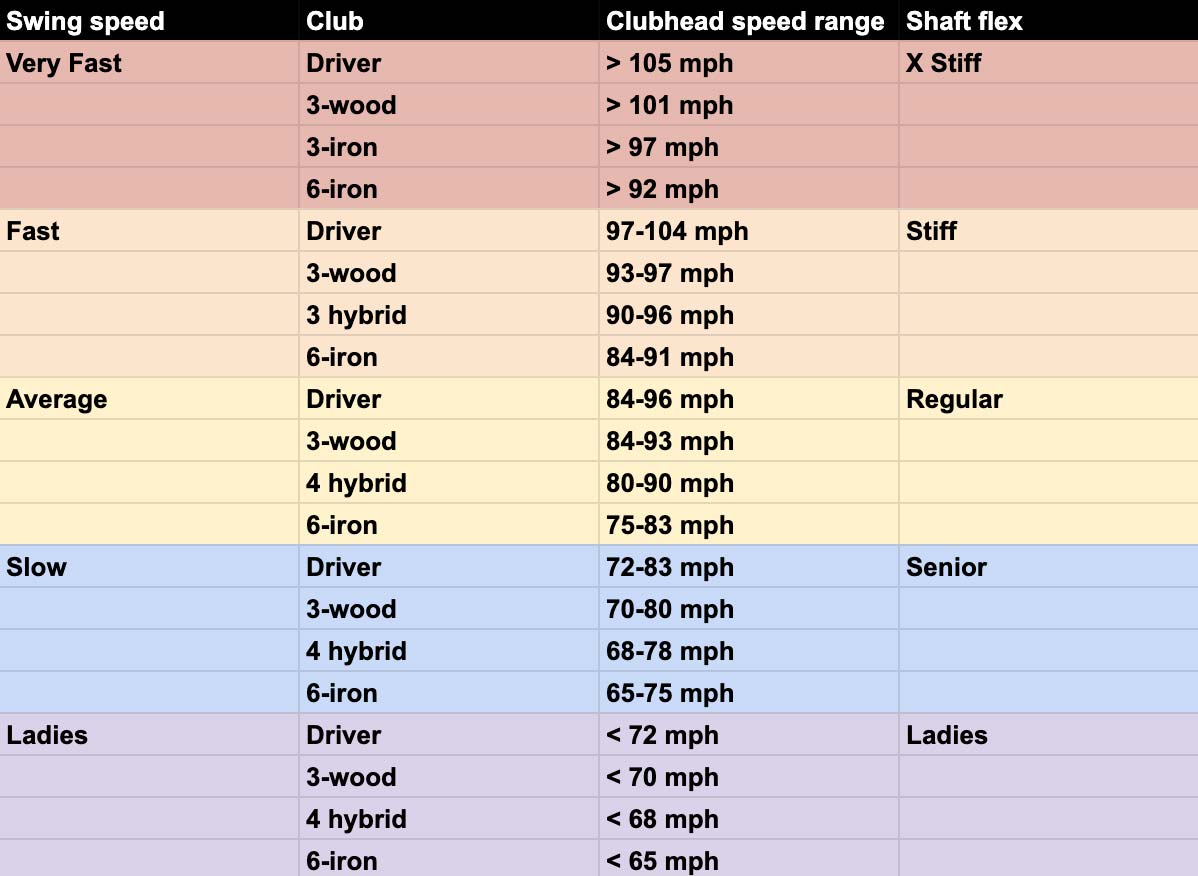
Here’s a quick breakdown of the data for drivers:
X-stiff – This is the range where most high-level players fall. If you’re swinging the driver above 105 mph, it might be time to get some X stiff shafts in your set.
Stiff – This range is still considered fast, but you most likely won’t be out on Tour anytime soon. If you’re between 97 and 104 mph with the driver, you need a stiff flex.
Regular – Now we are getting into the range where a majority of recreational golfers fall, and also where many LPGA pros fall. If you’re between 84 and 96 mph, regular is going to be best for you.
Senior – Slower swingers fall into this category. Between 72 and 83 mph signifies you need to be hitting senior flex.
Ladies – By no means do all women’s golfers will fall in this category, but this is where many of the recreational women’s players find themselves. This range is going to be for anyone with a swing speed slower than 72 mph.
These are all just general ranges for how swing speed translates to ideal shaft flex, but it is a good place to start. So if you can’t get to a fitter, at least figure out your swing speed and you’ll be headed in the right direction.
Editor’s Picks

Former NHL bruiser Jeremy Roenick says these two golfers could use some tough love

Field guide: This Colorado course is skyrocketing up the Top 100 in the World ranking

One thing to buy this week: Johnnie-O Ponto Printed golf polo

Best golf shoes: 10 comfortable pairs to buy for Father’s Day
Latest in instruction, tiger woods, fred couples deliver masterclass on 50-yard wedge shots, explaining what 'short-sided' means — and why you need to avoid it, this clubface hack is a quick-fix for those infuriating mishits, how much should you sway during the swing advanced tech shows us, zephyr melton.
Zephyr Melton is an assistant editor for GOLF.com where he spends his days blogging, producing and editing. Prior to joining the team at GOLF, he attended the University of Texas followed by stops with the Texas Golf Association, Team USA, the Green Bay Packers and the PGA Tour. He assists on all things instruction and covers amateur and women’s golf. He can be reached at [email protected].
- Author Twitter Account
- Author Instagram Account
Related Articles
Are you standing too far from the golf ball this test shows you, the scorecard doesn't *always* tell the full story. here's why, how a chair can help you perfect your swing rotation, how to add distance without completely changing your golf swing, ball care is essential for good golf (just not the type you're thinking), how to develop the traits that all great putters have in common, 9 ways to improve your mental game (and maintain your composure).

Tour Flex vs. Stiff Flex | What Is The Difference?
Choosing the right set of clubs that can help you improve your game can be challenging and time-consuming, as it requires you to take several factors into account, with one of the most important ones being the shaft’s flexibility level. When faced with this decision, you’re sometimes given a choice between a tour flex and a stiff flex, but how do you know which one is best suited to your preferences and playing style?
A tour flex speaks to a type of shaft that is rigid, stiff, and offers a great deal of control, which makes it ideal for pros and low-handicappers. A stiff flex, although more rigid than the regular variety, is still more flexible than the tour flex, meaning it’s better suited for mid-handicappers.
If you want to learn more about the differences between a tour and stiff flex, as well as which one would be better suited to your swing speed and overall playing style, stay tuned until the end of this article.
Tour Flex vs. Stiff Flex: A Comparison
For a quick, comprehensive comparison of a tour and stiff flex , refer to the table below.
Your takeaway from this table is this – a tour flex speaks to a stiffer, heavier shaft that offers a great deal of control but it’s also notably less forgiving than its stiff counterpart. That’s why this type of flex is best suited to more experienced, lower-handicap players who boast impressive swing speeds of 169 kph (105 mph) or more. On the other hand, if your swing speed falls somewhere between 154 kph (95 mph) and 169 kph (105 mph), a stiff flex might be better suited to you.
What Shaft Flex Should You Use?
Picking up where I left off, you can determine the type of shaft flex you should use by analyzing your swing speed, experience level, playing style, goals, and personal preferences.
The swing speed cutoff point of 169 kph (105 mph) I mentioned above can serve as a great starting point for your analysis, but it is by no means the be-all and end-all consideration (though if you do exceed this benchmark, a stiff flex is more likely to hold you back then improve your performance).
If you’re striving for distance and control instead of forgiveness, you can still benefit from a tour shaft even if you’re under the 169 kph benchmark. So always take your golfing style and experience into account.
If you want to learn more about how to find the right shaft flex for you (even if your swing speed is lower than 154 kph (95 mph), refer to the table in this article .
Whether you ultimately decide to go for a tour or stiff flex club, your research isn’t done here. You should still exercise caution when choosing a brand that can fit both your needs and budget. No matter the flexibility of the shaft, you want the overall equipment to be made with care and attention to detail.
Post navigation
Previous post.
No comments yet. Why don’t you start the discussion?
Leave a Reply
Your email address will not be published. Required fields are marked *

What Golf Club Shaft Flex Do I Need?
Last Updated on February 2, 2024 by Matt Greene
The shaft in your golf clubs connects your swing to the golf ball so playing the correct flex shaft is very important.
Playing the wrong golf shaft flex can lead to bad habits in your swing that become difficult to fix in future.
But playing the right flex for your swing promises you massive distance, straighter shots and longer carry.
This is a full guide on golf shaft flex including charts and expertise of club fitters, so you'll know everything there is to know about shafts by the end.
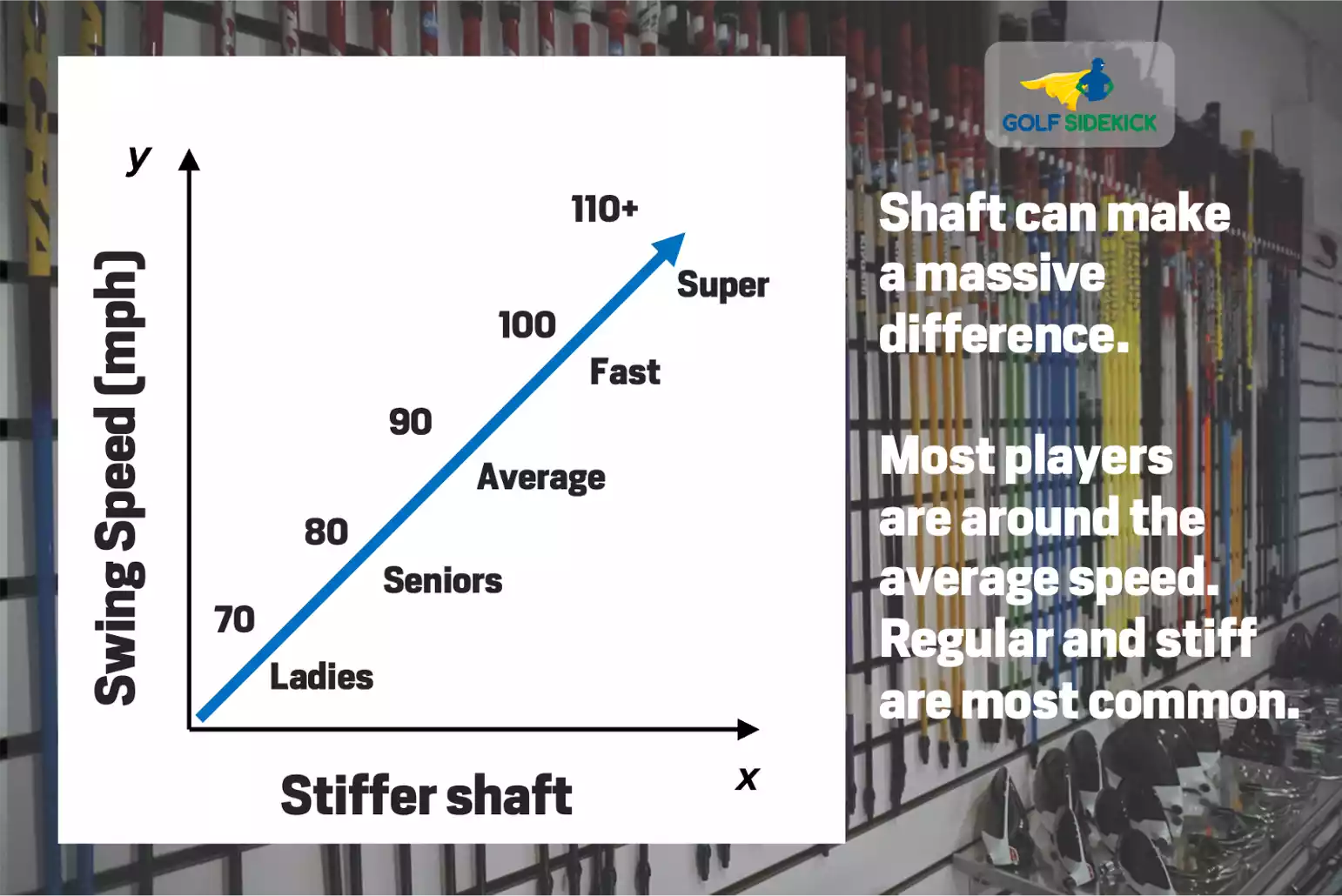
What Is Golf Shaft Flex?
Flex in a golf shaft determines the amount the shaft bends during the swing and at impact. Depending on the manufacturer, shafts fall into categories such as extra stiff, stiff, regular, ladies, or senior flex.
Pros or low handicap golfers, tend to use stiffer shafts to adjust to the faster swing speeds and torque generated by stronger golfers to give the club head the best chance of being in the exact position it needs to be at the point of contact.
Players with much slower swing speeds , such as juniors, seniors or lady golfers, use a softer flex shaft like Ladies or Senior flex to allow the club head to hit the ball with a square face.
What is torque in a golf shaft?
Torque is a measurement of how much a shaft resists twisting during the golf swing. It is measured in degrees, which denotes how many degrees the shaft will twist under a given force.
Torque is important. Feel is just as important in a golf swing. It's a complicated topic best solved by an expert fitter like Eric Chong from Impact Golf Malaysia.
Golf Shaft Flex Letters
Have you ever seen the letters on a golf shaft and not understood what they mean? Here's a clear breakdown of what golf shaft letters mean:
- SR = Soft Regular in America/Europe
- R = Regular flex
- SR = Stiff Regular in Asia
- S+ = Stiff Plus
- X = Extra stiff
- TX = Tour Extra stiff
Specialty shafts:
- L = Ladies flex
- A = Senior flex
- W = Wedge flex
Golf Club Shaft Flex Chart
This is a really useful golf shaft stiffness chart that matches up swing speeds to the appropriate flex. This is a good guide but as always, if in doubt, see a professional club fitter for advice because your tempo and transition determines the kick point in your shaft as well as the weight and flex.
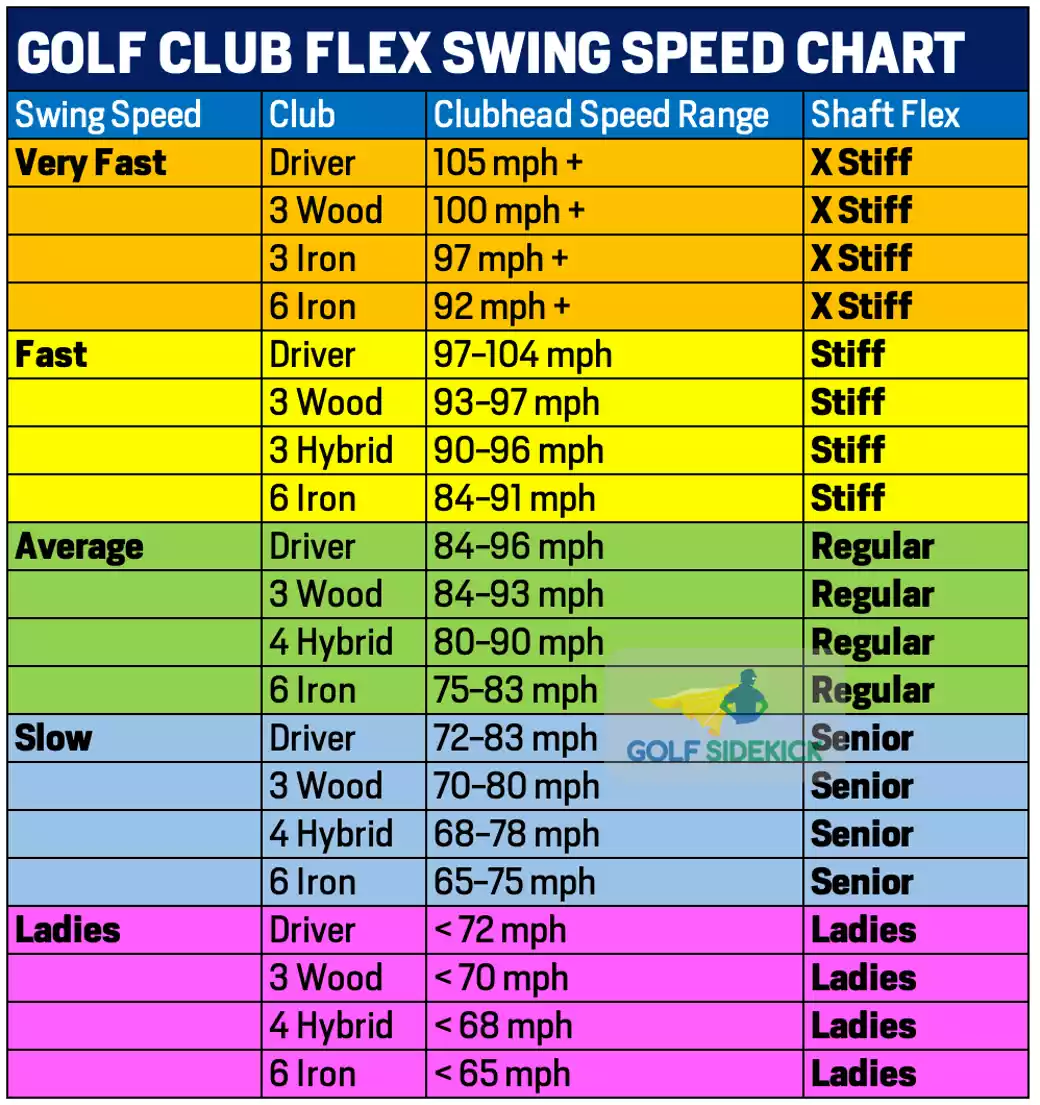
How the flex of the golf shaft impacts shot shape
The flexibility of the golf shaft affects your shots in the following ways:
- The shaft flex influences the launch height and overall height of your shots.
- The shaft influences how much spin you put on the ball.
- The shaft flex influences the feel of the golf club whether it feels like an extension of your body or something totally foreign.
Golfers with high swing speed must use stiffer shafts because when a soft shaft bends under high swing speed it "lags" behind where it should be and the club head can't catch up with your hands. At the bottom of the swing, near impact, the club face could be pointing left or right and that causes inconsistent shot shapes.
On the other end of the scale, if you're a golfer with a slower swing speed using a stiff shaft, you may struggle to close the club face at impact, resulting in a dreaded slice. Compressing the golf ball is key to more distance and with the correct shaft, a better strike of the golf ball will increase your distance, lower your spin and improve direction.
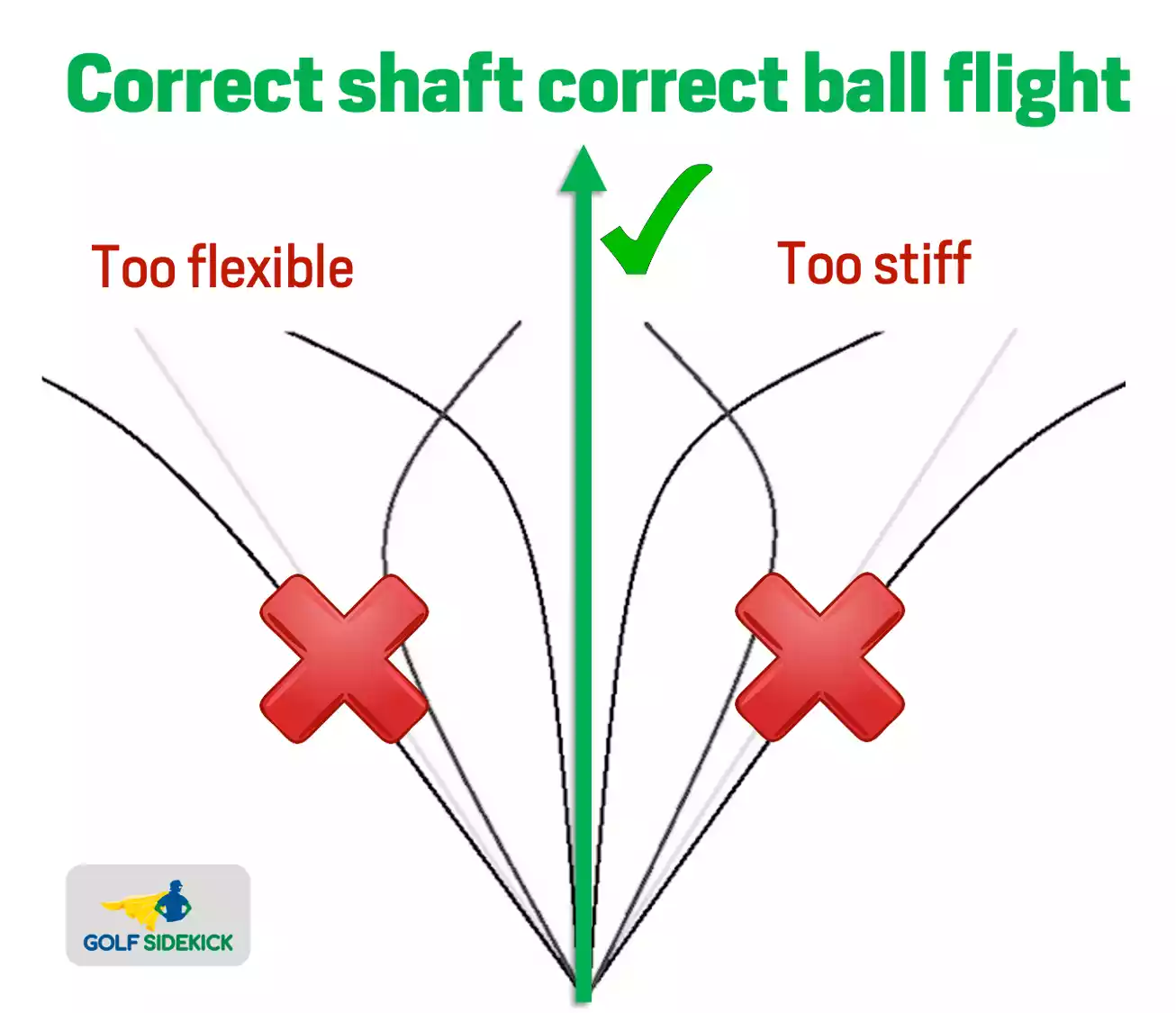
What we want is to manage the spin rate of the ball which is generated relative to the swing speed of the golf swing. More speed can result in more spin, and more spin can result in a loss of distance as the ball balloons in the air. However, spin is needed to get the ball airborne, so slower swing speed golfers need a shaft which generates enough spin to help them out in this area.
As a general rule, you should use the same flex shafts in all of your clubs, with the exception of your wedges. Wedges tend to have stiffer shafts, known as "wedge flex". They're not overly stiff, but they do encourage accuracy in these precision clubs.
You can judge the right flex shaft for you based on feel, and some people swear that in the hands of an amateur, flex doesn't matter. I think that shaft flex is an essential timing element in the golf swing, and to get this part of the game right, I always recommend seeking the help of a professional club fitter.
Shaft Flex by Golf Swing Speeds
Working out the correct shaft flex for you is usually done by working out your swing speed and then seeing which shaft flex is right for the club head speed you're generating. All of these speeds are with a driver.
- Under 75 mph – Ladies flex or Senior flex
- 75 to 95 mph – Regular flex
- 95 to 110 mph – Stiff flex
- 110 mph and up – Stiff or Extra Stiff
This is a basic guide to follow.
What Do Golf Shaft Flex Numbers Mean
Golf shaft brands like Project X use numbers on their golf shafts instead of letters to denote the flex of the shaft. For Project X shafts, the higher the number on the shaft, the stiffer the shaft.
Project X Golf Shaft Flex Chart
- 7.0 - Tour extra stiff
- 6.5 - Extra stiff
- 6.0 - Stiff flex
- 5.5 - Regular flex
- 5.0 - Senior flex
Signs you need a stiffer shaft
As you get better at the game of golf, our develop a more confident swing, you may begin to think that you need a stiffer shaft in your clubs. There are a few signs that this might be the case which are;
- You're hooking the ball with your clubs
- You can't control the distance of your irons consistently
- The golf ball balloons in the air with driver, hybrids and fairway woods
- You can't feel the club head in your swing
When to switch from stiff to regular shaft
I often find that too many players use stiff flex shafts. There is nothing wrong using a regular flex shaft and in truth shaft flex has no relation to skill level in golf. I have played with and had my ass kicked by plenty of seniors who are using super light and whippy shafts.
Here are some signs that it's time to switch from a stiff to a regular shaft;
- You are hitting slices with your driver
- You can't get the ball of the ground with woods and long irons
- Ball flight is weak with mid and short irons
- No spin on approach shots
These are some of the tell tale signs of a shaft which is too stiff for you.
What Shaft Flex Should I Use For My Driver
If you’re between 97 and 104 mph with the driver, you need a stiff flex.
If you’re between 84 and 96 mph , regular is going to be best for you. This is the swing speed rage of most amateur golfers.
Between 72 and 83 mph with the driver signifies you need to be hitting senior flex.
Swing speed for stiff shaft irons

7-iron swing speed chart shaft flex
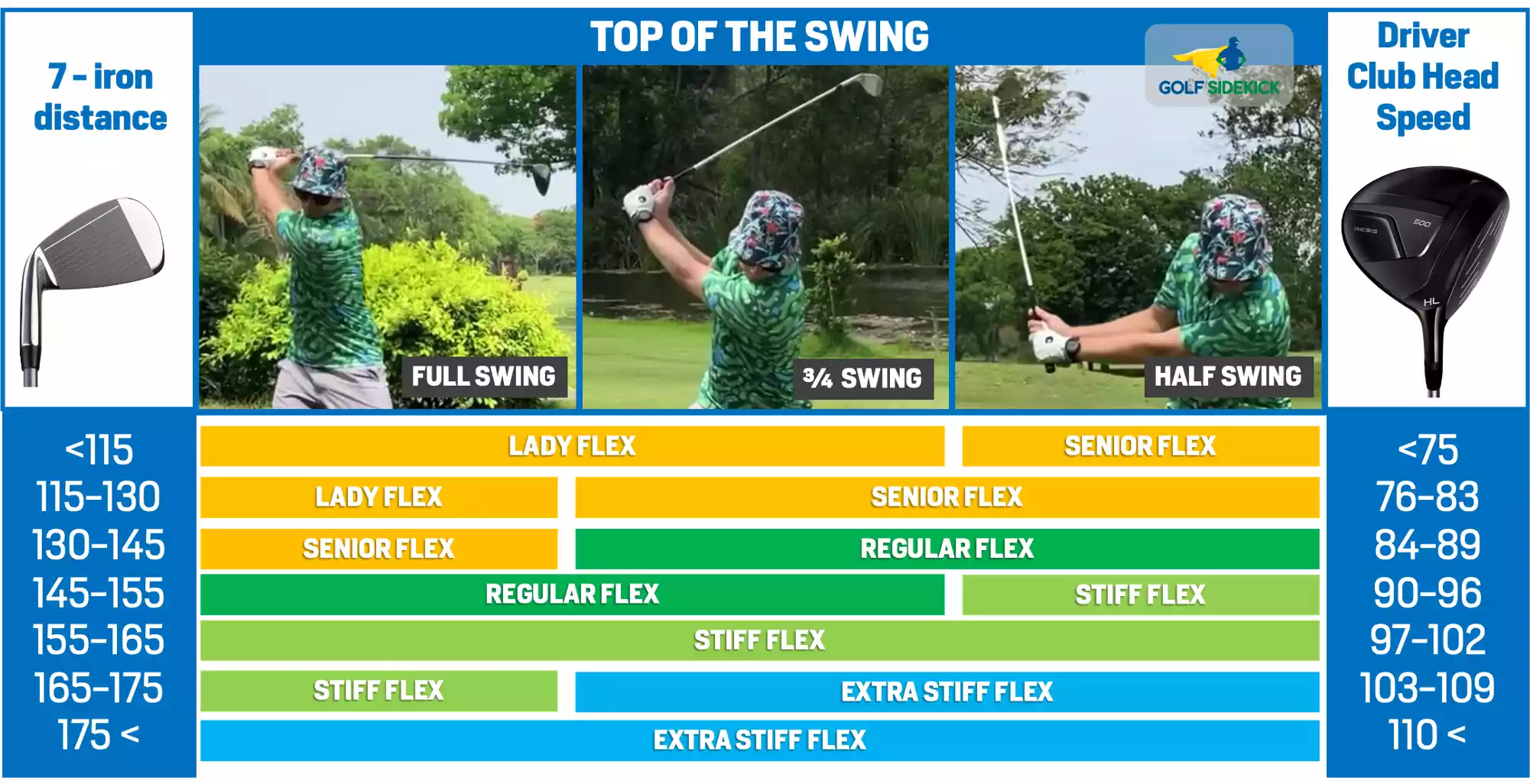
KBS shaft chart

Project X Shaft Flex Chart
Original project x rifle irons.
- Regular – 5.0
- Regular Plus – 5.5
- Stiff – 6.0
- Extra Stiff – 6.5
- Extra Stiff Plus – 7.0
- Stiff – 6.0
- Extra Stiff – 6.5
Original Project X Woods & Hybrids
- Regular Plus – 5.0
- Stiff – 5.5
- Stiff Plus – 6.0
- Extra Stiff Plus – 7.0
Project X 95 Flighted Irons
- Regular Plus – 5.5
- Stiff Plus – 6.0
Rifle Irons
- Senior – 4.0
- Extra Stiff – 7.0
- Senior Plus – 4.5
PX LZ Steel Irons
- Stiff Plus – 6.5
PX LZ Tour Graphite Irons
Pxv tour graphite woods.
- Stiff – 5.5
- Extra Stiff Flex – 6.5
- Extra Stiff Plus – 7.0
Project X Black Woods & Hybrids
HZRDUS Woods & Hybrids
Hzrdus t1100 woods, evenflow woods & hybrids.
( Available in Black and Blue )
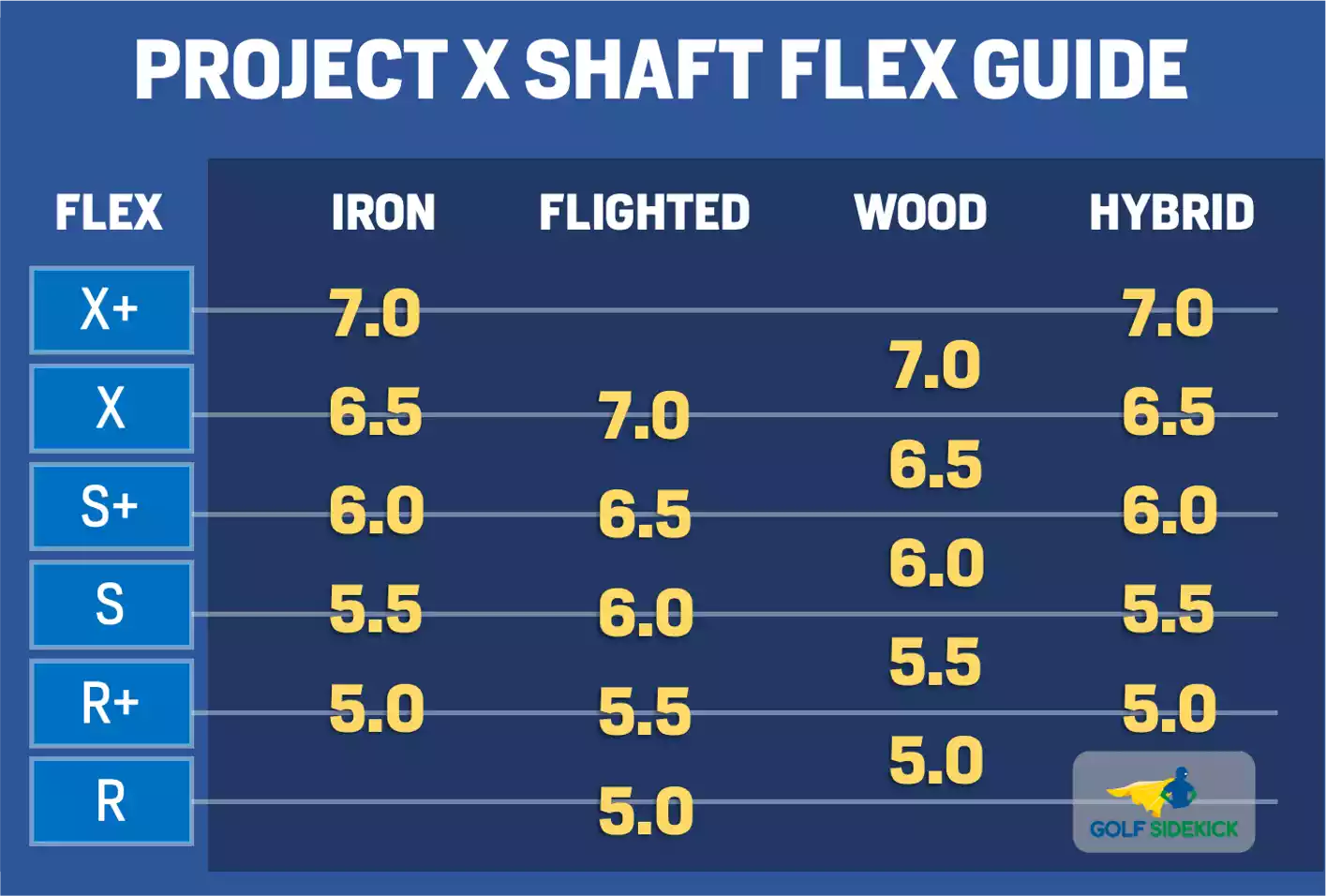
Using the correct shaft flex for your game is essential. You don't want to add shots because of your equipment and a poorly fitted shaft could be the cause of those wild hooks and slices. See a pro club fitter and get the right shaft for you.
Tour Flex vs Stiff Flex: The Definitive Guide
Are you a golf enthusiast searching for the perfect combination of power and accuracy on the green? Look no further than the debate of tour flex vs stiff flex. As any seasoned golfer knows, choosing the right flex for your swing can make all the difference in your game.
In this article, we’ll explore the differences between tour flex and stiff flex and help you determine the right choice for your unique swing style. So grab your clubs, settle in, and let’s dive into the world of golf shaft flexes.
Table of Contents
Understanding Golf Club Shaft Flex
To better understand the difference between tour flex and stiff flex, it’s vital to have a solid understanding of golf club shaft flex.
When it comes to golf, the “flex” of a shaft refers to its ability to bend during your swing. The more a shaft flexes, the more power it can generate, but the less accurate your shots may be. Conversely, a stiffer shaft provides more control and accuracy but with less power.
When choosing a golf club , the shaft flex should be tailored to your swing speed and tempo. If you have a fast swing speed, you may benefit from a shaft with more flex, while slower swing speeds may require a stiffer shaft. The same flex may feel different depending on the weight and length of the club, as well as other factors.
In addition to tour flex and stiff flex, other common shaft flex options include regular flex, senior flex, and ladies flex. Understanding the nuances of each type of shaft flex can help you make an informed decision when selecting your golf clubs.
Tour flex is a shaft flex designed for advanced golfers with high swing speeds. The tour flex shaft is the most flexible option available, providing the most clubhead speed and distance potential.
However, this flexibility also means that it requires more control and accuracy from the golfer. Tour flex is not recommended if you have a slow swing speed or struggle with control.
Stiff Flex Shaft
Stiff flex is a shaft flex designed for golfers with fast swing speeds. The stiff flex shaft is less flexible than the tour flex and provides more control and accuracy.
This stiffness means it is easier to hit the ball straight and with consistency, making it an excellent option for golfers who struggle with accuracy or have a faster swing speed.
After understanding the shaft flex, let’s examine stiff flex vs tour flex in detail.
Tour Flex vs Stiff Flex: Comparison
Let’s dive deeper into comparing tour flex and stiff flex golf shafts.
Flexibility
Tour flex is the most flexible option available and provides the most distance potential due to the increased clubhead speed it generates. On the other hand, stiff flex is less flexible and is designed to provide more control and accuracy over distance.
Swing Speed
Your swing speed is critical when choosing between tour flex and stiff flex. Tour flex suits advanced golfers with high swing speeds, typically above 100 mph. On the other hand, stiff flex shaft is ideal for golfers with fast swing speeds of 90-100 mph.
Tour flex provides more distance potential due to its increased clubhead speed but requires more control and accuracy. Stiff flex is less likely to offer the same level of distance, but it makes up for it with improved control and accuracy.
Accuracy is an essential component of the game, and your choice of shaft flex can significantly impact your accuracy.
Stiff flex provides more control and accuracy, making it an excellent option for golfers who struggle with accuracy. Tour flex requires advanced control and precision and may not be suitable for golfers who struggle with consistency.
The shaft flex can also affect the ball’s trajectory. Tour flex is more likely to provide a higher ball flight due to the increased clubhead speed it generates. In contrast, stiff flex produces a lower ball flight, making it ideal for golfers looking for a more penetrating ball flight.
Your choice of shaft flex can also impact your shot shape. Stiff flex provides more control and is ideal for golfers looking to hit straighter shots. On the other hand, Tour flex requires advanced control and can be used to shape shots more effectively.
Verdict on Tour Flex vs Stiff Flex
The right shaft flex depends on your swing characteristics and skill level. If you have a fast swing speed and struggle with accuracy, stiff flex is likely the better option.
If you have an advanced level of skill and control and are looking to maximize distance potential, tour flex may be the better choice.
Working with a professional fitter to determine the best shaft flex for your game is always advisable.
Chad holds an Associates Degree in Landscaping and has been working on Lawns since he was 10 years old. He created this blog to share lawn care advise and landscaping tips.

Stiff vs Extra Stiff Driver Shaft: Choose the Right One

Golfers of all skill levels know that the right driver can make or break their game. One of the most important factors to consider when selecting a driver is the shaft’s stiffness. The two most common options are stiff and extra stiff, each with its own benefits and drawbacks.
Stiff shafts are ideal for golfers with moderate to fast swing speeds. They provide a balance between control and distance, making them a popular choice for many players.
Extra stiff shafts, on the other hand, are designed for golfers with exceptionally fast swing speeds.
They offer more control and accuracy but may sacrifice some distance. It’s important to note that swing speed is the most significant factor when choosing between the two options.
Table of Contents
Understanding Shaft Flex
Golfers must understand the importance of the shaft flex when choosing a driver. The shaft flex pertains to the stiffness of the shaft and its ability to bend during the swing. The golfer’s swing speed determines the appropriate shaft flex, with faster swing speeds requiring stiffer shafts.
There are several types of shaft flexes available, including regular, stiff, extra stiff, ladies, and senior. The regular shaft flex is the most flexible, making it ideal for golfers with slower swing speeds.
The stiff shaft flex is stiffer than the regular, making it suitable for golfers with faster swing speeds. The extra stiff shaft flex is the stiffest option, designed for golfers with the fastest swing speeds.
Shaft stiffness affects the launch angle, ball spin, and accuracy of the shot. A shaft that is too flexible may cause the ball to fly too high, resulting in a loss of distance.
On the other hand, a shaft that is too stiff may cause the ball to fly too low, also resulting in a loss of distance.
Golfers can determine the appropriate shaft flex by measuring their swing speed. A swing speed of less than 85 mph is ideal for a regular shaft flex, while a swing speed between 85 and 95 mph is suitable for a stiff shaft flex. Golfers with swing speeds above 95 mph may require an extra stiff shaft flex.
The Role of Swing Speed
Swing speed is a crucial factor in determining which driver shaft flex to use. The speed at which a golfer swings the club determines the amount of flex the shaft needs to have to optimize performance.
A golfer with a slower swing speed requires a more flexible shaft, while a golfer with a faster swing speed requires a stiffer shaft.
Fast swing speeds typically range from 105 mph and above. For golfers with fast swing speeds, an extra stiff driver shaft is recommended.
This range is where most high-level players fall. X-stiff shafts provide more stability and control, which is essential for golfers who swing exceptionally fast.
On the other hand, golfers with swing speeds in the range of 95-105 mph should use a stiff driver shaft. Stiff shafts provide the perfect balance of control and flexibility for golfers with moderate swing speeds. It is the most common flex used by amateur golfers.
For golfers with swing speeds below 95 mph, a regular flex driver shaft is recommended. Regular flex shafts are more flexible, which helps generate more clubhead speed and distance for golfers with slower swing speeds.
Stiff vs Extra Stiff Driver Shafts
When it comes to choosing a driver shaft, one of the most important factors to consider is the flex. The flex of a shaft refers to how much it bends during the swing, and it has a significant impact on the launch, spin, and accuracy of the ball.
There are several different flex options available, but two of the most popular options are stiff and extra stiff.
A stiff shaft is designed for golfers with a faster swing speed. It is less flexible than a regular shaft, which means that it doesn’t bend as much during the swing.
This results in a lower ball flight and less spin, which can be beneficial for golfers who tend to hit the ball too high or with too much spin.
Stiff shafts are also more stable and provide better control, which can help golfers hit the ball straighter.
On the other hand, an extra stiff shaft is even less flexible than a stiff shaft. It is designed for golfers with an exceptionally fast swing speed, typically above 105 mph.
Extra stiff shafts are becoming more popular as golfers continue to swing clubs faster with the help of modern club technology.
The extra stiffness of the shaft can help reduce spin and provide even more control, which can be especially beneficial for golfers who struggle with accuracy.
When deciding between a stiff and extra stiff shaft, it’s important to consider your swing speed. If you swing the driver above 95 mph, a stiff shaft may be a good choice. If you swing the driver above 105 mph, an extra stiff shaft may be a better option.
However, it’s also important to consider your ball flight and spin rate, as well as your personal preferences and feel.
Impact on Ball Flight and Distance
The stiffness of a driver shaft has a significant impact on the ball flight and distance. A stiff shaft will generally produce a lower ball flight with less spin, resulting in a longer carry distance.
An extra stiff shaft will produce an even lower ball flight, with even less spin, resulting in even more carry distance.
However, a lower ball flight may not be suitable for golfers who need more height to carry obstacles or stop the ball on the green.
The launch angle of the ball off the clubface is also affected by the stiffness of the shaft. A stiff shaft will produce a lower launch angle than an extra stiff shaft.
This can be an advantage for golfers who need to keep the ball flight low to avoid wind or to get more roll on the fairway.
However, golfers who need a higher launch angle to carry obstacles or stop the ball on the green may benefit from using an extra stiff shaft.
The impact of the ball on the clubface is also affected by the stiffness of the shaft. A stiffer shaft will transmit more of the impact force to the golfer’s hands and arms, resulting in more feedback and control.
An extra stiff shaft will transmit even more impact force, resulting in even more feedback and control. However, golfers who have a slower swing speed may find it difficult to control an extra stiff shaft.
Choosing the Right Shaft for Your Game
Choosing the right shaft for your driver is crucial to your game. A shaft that’s too stiff or too flexible can significantly impact your performance on the course. Therefore, it’s essential to select the correct shaft that matches your swing speed, tempo, and ball flight.
Factors to Consider
When choosing between a stiff and extra stiff driver shaft, several factors come into play. The most important factor is your swing speed. Golfers with a swing speed of 95 to 105 mph will do best with a stiff flex golf shaft.
On the other hand, golfers who swing their driver more than 105 mph will be best suited using an extra stiff flex.
Another factor to consider is your ball flight. Golfers who tend to hit high shots should opt for a stiffer shaft, while golfers who hit low shots should choose a more flexible shaft.
Additionally, the type of club head you use can also impact your shaft choice. A club head with a closed face may require a more flexible shaft, while an open face may require a stiffer shaft.
Fitting Process
It’s essential to get fitted for your driver shaft to ensure that you’re using the correct one for your swing. A club fitter can help you determine the best shaft for your game by analyzing your swing speed, tempo, and ball flight. They will also consider other factors such as your height, weight, and strength.
True Spec Golf is one of the leading club-fitting companies in the industry. They use state-of-the-art technology to analyze your swing and help you select the perfect shaft for your game.
Material Considerations
When deciding between a stiff and extra stiff driver shaft, one important factor to consider is the material of the shaft. The two most common materials used in driver shafts are graphite and steel .
Graphite shafts are typically lighter and more flexible than steel shafts, which can help increase swing speed and distance. They also tend to have a softer feel, which can be more comfortable for some golfers. However, graphite shafts can be more expensive than steel shafts and may not be as durable.
Steel shafts, on the other hand, are generally heavier and stiffer than graphite shafts. This can help provide more control and accuracy, especially for golfers with a faster swing speed. Steel shafts are also typically more affordable and durable than graphite shafts.
When it comes to choosing between a stiff and extra stiff shaft, the material of the shaft can impact the overall stiffness of the club.
Impact on Accuracy and Control
The stiffness of a driver shaft can have a significant impact on the accuracy and control of a golfer’s shots.
A shaft that is too flexible can result in inconsistent shots and a lack of control, while a shaft that is too stiff can cause the ball to go off in the wrong direction.
One of the main factors that affects accuracy and control is the dispersion of shots. A stiffer shaft can help to reduce the dispersion of shots, which means that the ball will be more likely to go where the golfer wants it to go.
This is because a stiffer shaft will provide more stability and control, which can help to prevent the clubhead from twisting at impact.
Another important factor is the direction of shots. A stiffer shaft can help to promote a straighter ball flight, which can be especially beneficial for golfers who tend to slice or hook the ball.
This is because a stiffer shaft can help to reduce the amount of spin on the ball, which can help to keep it on a straighter path.
Understanding Loft and Spin
Loft and spin are two key factors that affect the trajectory and distance of a golf ball. The loft of a driver refers to the angle between the face of the club and the ground.
Higher lofted drivers tend to launch the ball higher and with more backspin, while lower lofted drivers tend to launch the ball lower and with less backspin.
Spin, on the other hand, refers to the amount of rotation that the ball has while it is in the air.
Too much spin can cause the ball to balloon and lose distance, while too little spin can cause the ball to fall out of the air too quickly and also lose distance.
When it comes to choosing between a stiff and extra stiff driver shaft, the amount of spin that the shaft generates can be a key factor to consider.
Generally speaking, a stiffer shaft will produce less spin, while a more flexible shaft will produce more spin.
Players with faster swing speeds may benefit from a stiffer shaft that produces lower spin rates, as this can help them achieve a more penetrating ball flight and maximize their distance.
However, it’s important to note that using a shaft that is too stiff can also lead to inconsistent ball flight and a loss of accuracy.
It’s also worth noting that the loft of a driver can have a significant impact on spin rates. In general, lower-lofted drivers will produce less spin, while higher-lofted drivers will produce more spin. However, the optimal loft for a player will depend on their swing characteristics and launch conditions.
Signs You Need a Stiffer Shaft
Golfers who want to get the most out of their game need to make sure they have the right equipment. One of the most important pieces of golf equipment is the driver shaft.
The driver shaft is responsible for transferring the energy from the golfer’s swing to the ball, which is why it’s critical to have the right flex.
Here are some signs that a golfer may need a stiffer shaft :
- Loss of Distance: If a golfer is losing distance on their drives, it could be a sign that their driver shaft is too flexible. When a shaft is too flexible, it can cause the clubhead to lag behind the golfer’s swing, resulting in a loss of distance.
- Inconsistent Ball Flight: If a golfer is experiencing inconsistent ball flight, it could be a sign that their driver shaft is too flexible. When a shaft is too flexible, it can cause the clubhead to twist at impact, resulting in a hook or slice.
- Poor Accuracy: If a golfer is struggling with accuracy, it could be a sign that their driver shaft is too flexible. When a shaft is too flexible, it can cause the club head to open or close at impact, resulting in shots that miss the target.
So, should a golfer use a stiff or extra stiff shaft? It depends on their swing speed. Golfers with a swing speed of 95 to 105 mph will do best with a stiff flex golf shaft.
If a golfer’s swing speed is over 105 mph, they may need an extra stiff shaft to get the most out of their game.
Professional Insights
Professional golfers often rely on their equipment to help them perform at the highest level. When it comes to driver shafts, there are two main options: stiff and extra stiff. Here are some insights from professionals on the topic.
Pros and Cons
One of the main advantages of using an extra stiff driver shaft is increased accuracy. This is because the shaft is less likely to flex during the swing, resulting in a more consistent shot.
Additionally, extra stiff shafts can help increase ball speed and distance for golfers with fast swing speeds.
On the other hand, a stiff driver shaft can provide more flex, which can be beneficial for golfers with slower swing speeds.
This can help them generate more clubhead speed and distance. However, a stiff shaft may also result in less accuracy and consistency.
Tour Insights
According to a breakdown of the top 100 PGA Tour players, over 80% of them use extra stiff or tour extra stiff driver shafts.
This is because these players typically have fast swing speeds and need the added stability and control that an extra stiff shaft provides.
Frequently Asked Questions
Is an extra stiff shaft good for beginners.
Extra stiff shafts are generally not recommended for beginners. They require a higher level of skill and physical ability to use effectively. Beginners should start with a regular or stiff shaft .
Do all PGA pros use extra stiff shafts?
No, not all PGA pros use extra stiff shafts. The choice of shaft stiffness is a personal preference and depends on the golfer’s swing speed, skill level, and other factors.
Leave a Comment Cancel reply
Save my name, email, and website in this browser for the next time I comment.
Keep in mind that we may receive commissions when you click our links and make purchases. However, this does not impact our reviews and comparisons. We try our best to keep things fair and balanced, in order to help you make the best choice for you.
As an Amazon Associate, I earn from qualifying purchases.
© EXPGOLFER

True Temper Elevate Tour Shaft Review – Specs, Flex, Weight
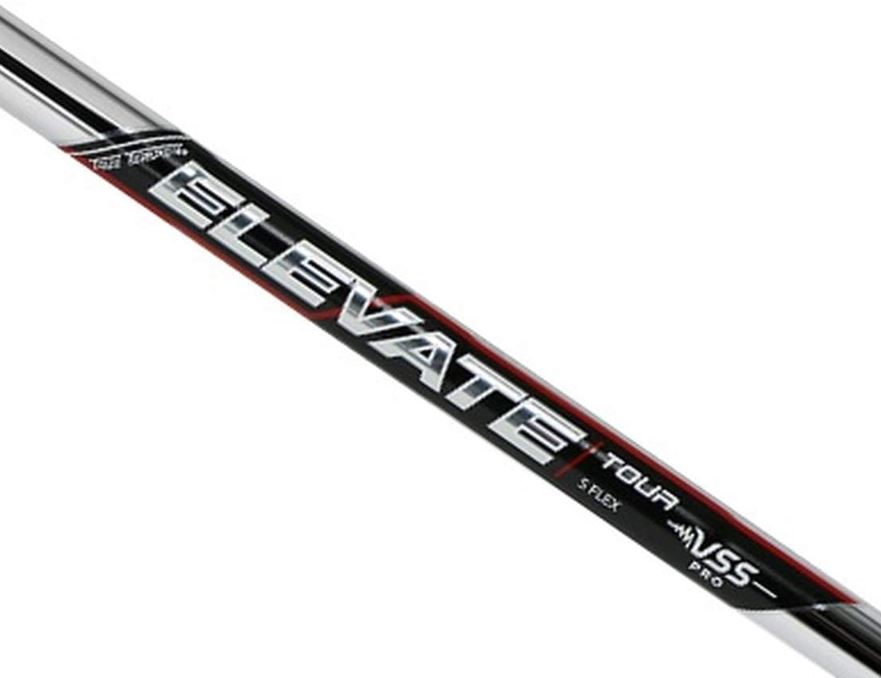
The True Temper Elevate Tour shaft is a bit of an anomaly in today’s steel iron shaft market.
Conventional wisdom tells us that top-tier players are all after low spin and low launch. But one size does not fit all in the game of golf.
I applaud True Temper for going against the grain a bit with the True Temper Elevate Tour: a shaft that is still geared towards better players; but one that promises mid spin and mid launch.
But are these shafts really for scratch players? Let’s talk about it.
True Temper Elevate Tour Shaft Overview
The True Temper Elevate Tour certainly looks the part of a Tour-grade shaft.
It has a very traditional stepped steel design with a polished finish. All the branding is contained within a band in the middle of the shaft – very reminiscent of KBS and True Temper shafts.
Even as a mid weight steel shaft, the True Temper Elevate Tour feels substantial in the hands.
It’s not cumbersome in any way; but you can feel that there will be some power behind your swing so long as you can handle the weight. I wouldn’t describe the feel of this shaft as stable so much as reactive.
If you take a really aggressive swing, you feel it sort of release too early. However, if you control your swing a bit more, it seems to load and release at the perfect time.
So the feel is really dependent on how you swing this shaft. Everyone will have a different experience but it seems that the True Temper Elevate Tour favors a more moderate transition.

Why is the True Temper Elevate Tour So Popular?
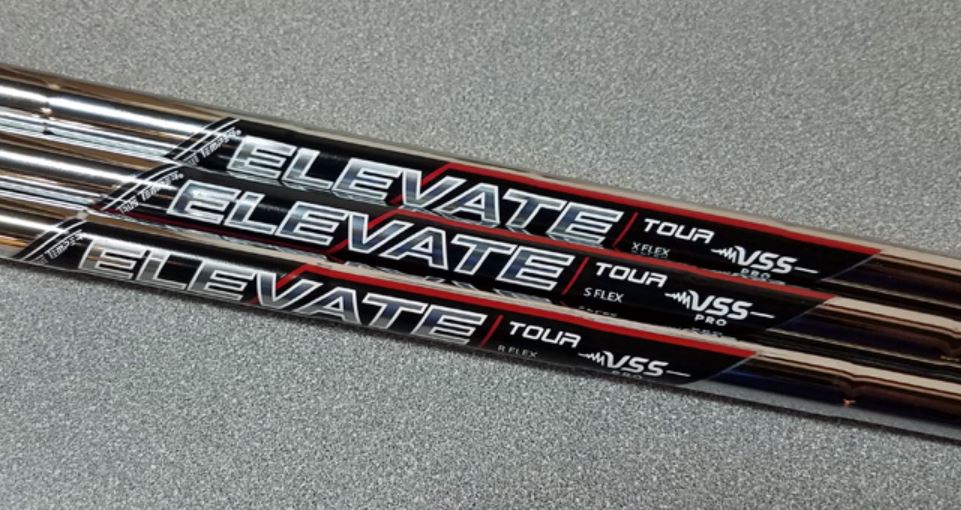
The True Temper Elevate Tour was designed with the input of Tour pros who wanted more spin from their iron shafts.
These are tour-weighted shafts with unique launch properties. They are great for counteracting the performance of modern player’s performance irons and their increasingly strong lofts.
I would say that this is what can be attributed to the niche popularity that the True Temper Elevate Tour has enjoyed.
How Does the True Temper Elevate Tour Perform?
The description of the True Temper Elevate Tour shafts as “mid launch” is accurate; but it doesn’t tell the whole story.
I really loved the launch I was able to get from this shaft because it was workable.
Naturally – and with a smooth tempo – the True Temper Elevate Tour wants to produce a launch just above piercing, right in the mid range.
This is a great level for anyone who needs to get their launch up just a bit for more carry.
But I found that I was able to flight the ball even higher when I needed to land soft on the green.
Even with my long irons, the True Temper Elevate Tour shafts allowed my ball to stop dead after one bounce and bit onto the green.
On long par 4’s, I was still able to get launch that was closer to “piercing.” Overall, I was really happy with the flight windows my shots were staying in.
True to the marketing, the True Temper Elevate Tour are also naturally mid spin shafts.
Again, I was really pleased in this department because there was just the right amount of spin for shot shaping. And the spin never got so high that I had to worry about slicing on mis-hits.
Pushes certainly did get wider on mis-hits and ended up further left from the line than what is optimal; but that has more to do with the golfer than the shaft.
You get really good control overall with this shaft.
Shaft Specs
What flexes are available what swing speeds do they suit.
Regular would be a good choice for 80-85 MPH swing speed golfers.
Stiff flex was a good fit for my swing which lays between 86 and 95 MPH.
Extra stiff might be more advantageous for players in the 96-105 MPH range.
What Weights Are Available? What Swing Speeds Do They Suit?
The 112g version is for players in the 80-85 MPH swing speed range.
The 117g version is better for 86-95 MPH swingers. The 122g version is for 96+ MPH swingers.
Why is it So Good?
The True Temper Elevate Tour is a great shaft because it offers a really nice combo of launch and spin.
It’s right in the middle so there is some workability; but at the same time, you don’t have to worry about ballooning or slicing.
True Temper Elevate Tour First Impressions
I thought the True Temper Elevate Tour felt a little hefty in my hands at first but I soon forgot about that after a few swings.
I fell into a groove with it pretty quickly; though it should be noted that I had to make a conscious effort to dial back on my transition.
Key Features & Performance
The True Temper Elevate Tour features the Vibration Suppression System which mutes vibration on mis-hits.
This technology seems to work as mis-hits weren’t jarring nor were they totally muted.
True Temper Elevate Tour Irons Review
Long approaches stopped dead on the green like a dream. I was getting some great GIRs with just a slight tweak to my swing.
True Temper Elevate Tour Wedges Review
When you are facing a fast green, you can impart more spin on the wedges. You can also maintain the mid spin rates if you want.
True Temper Elevate Tour Pros & Cons
- Good dispersion
- Workable spin
- Workable launch
- Good stopping power
- Not ideal for aggressive tempos

Overall Score: 97/100
Check out more reviews here:.
Who Should Buy it?
Is the True Temper Elevate Tour really for top-tier players?
Yes and no. I got optimal performance when I slowed my tempo down. Most scratch players will have an aggressive tempo.
But as long as you can reign it in a bit, the True Temper Elevate Tour will perform very well.

Project X Denali Blue 60TX Shaft Review - Specs, Flex, Weight
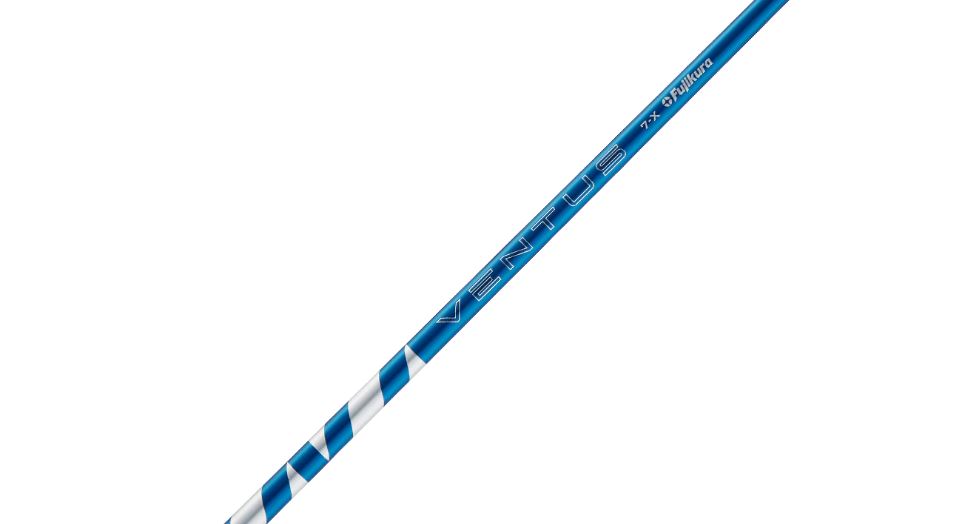
Fujikura 2024 Ventus Blue Shaft Review - Specs, Flex, Weight
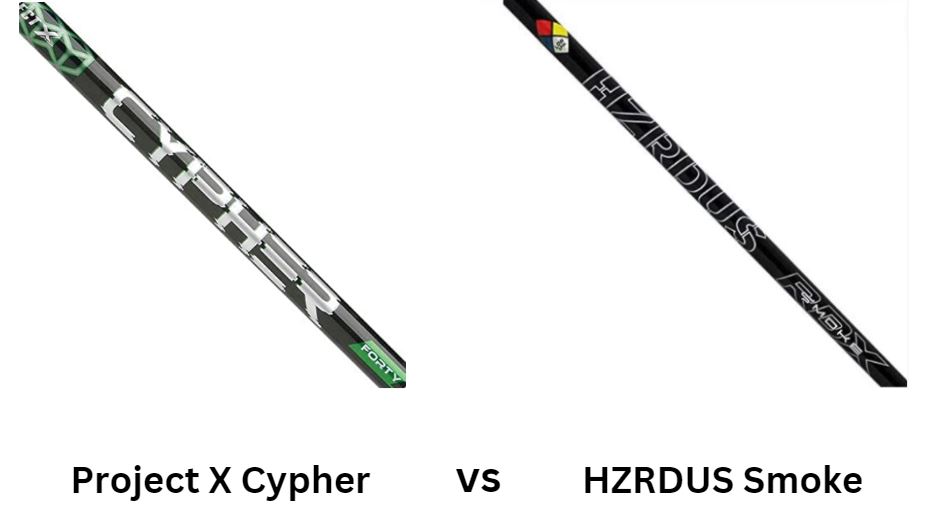
Project X Cypher Vs HZRDUS Smoke Shaft Comparison
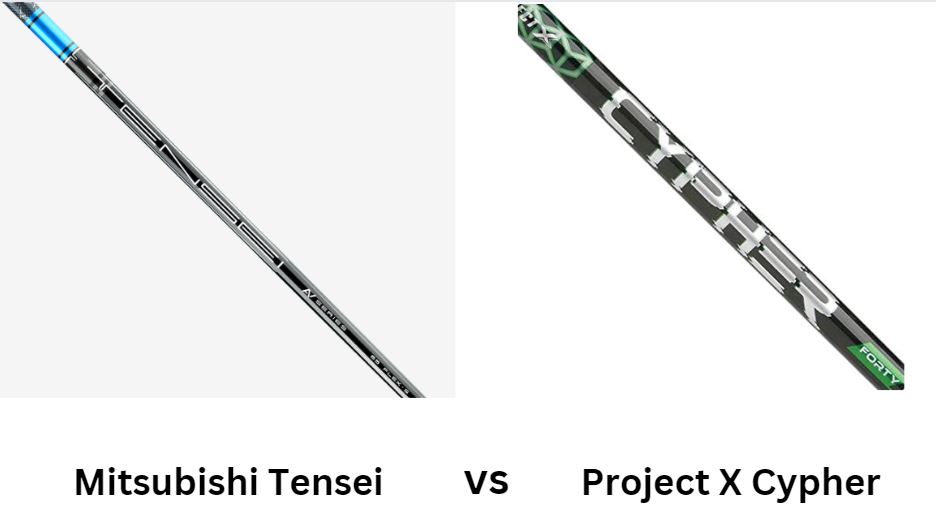
Mitsubishi Tensei Vs Project X Cypher Shaft Comparison

Tour AD DI Hybrid Shaft Review - Specs, Flex, Weight
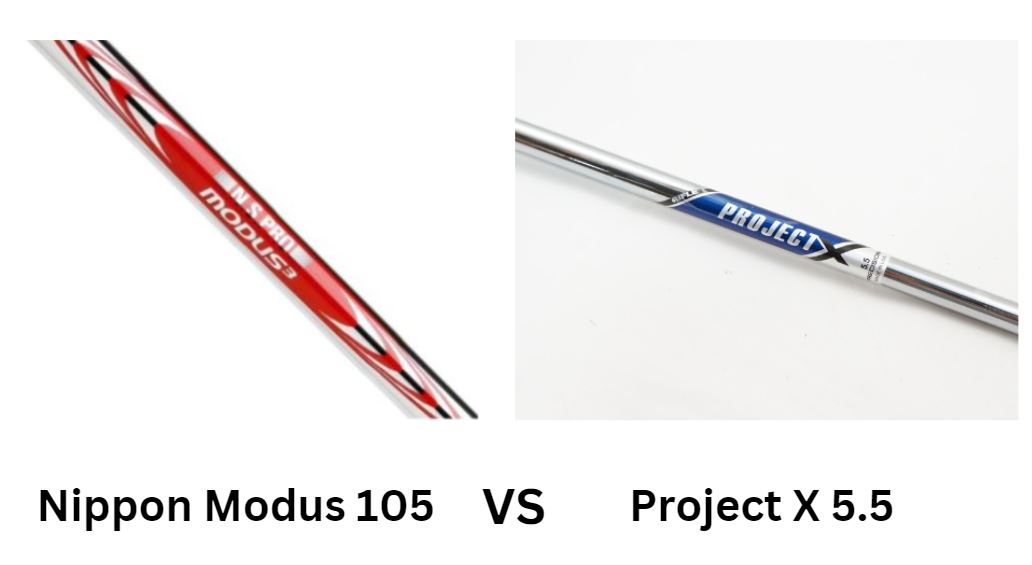
Nippon Modus 105 Vs Project X 5.5 Shaft Comparison
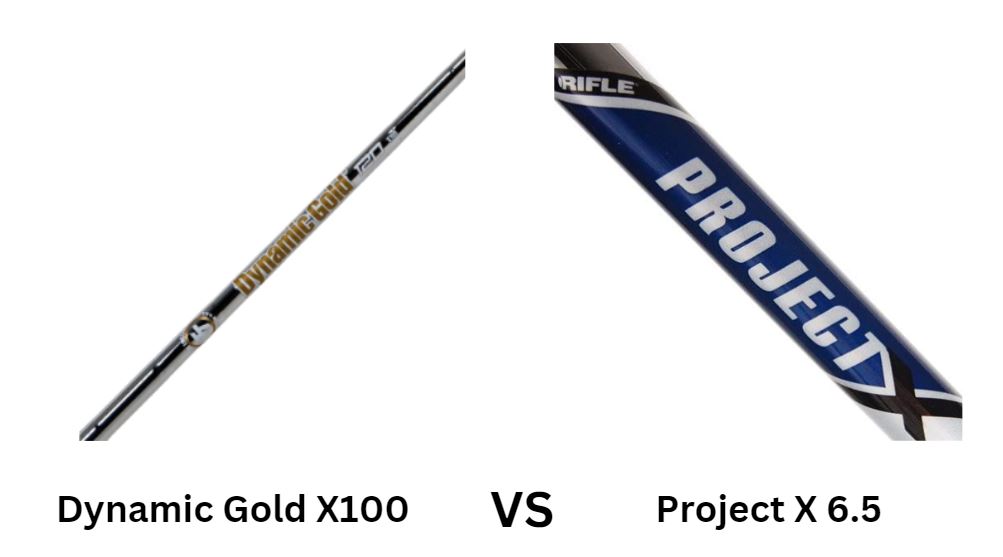
Dynamic Gold X100 Vs Project X 6.5 Shaft Comparison
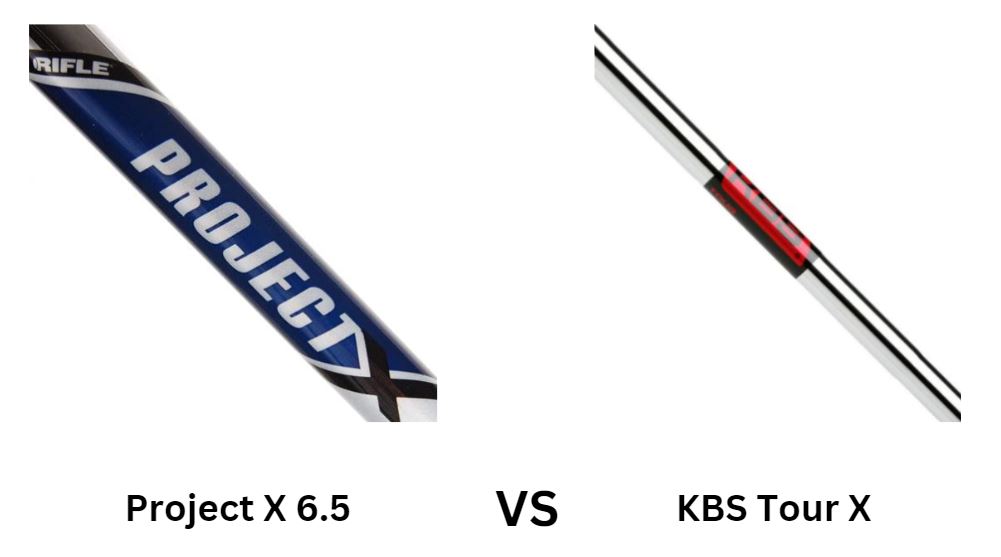
Project X 6.5 Vs KBS Tour X Shaft Comparison
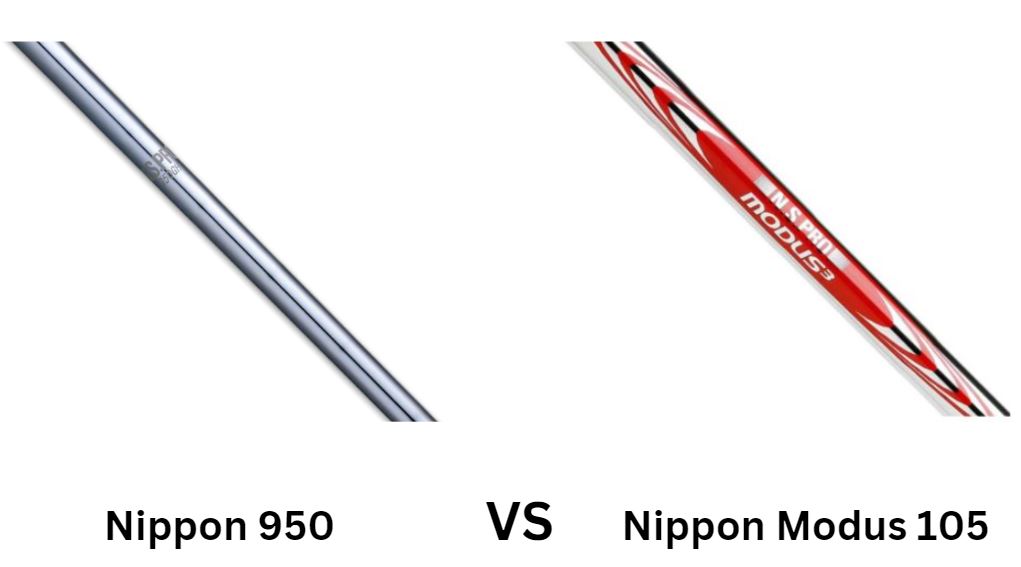
Nippon 950 Vs Nippon Modus 105 Shaft Comparison
© 2022 Amazon Associates Program. Golf Blue Heron is a participant in the Amazon Services LLC Associates Program, an affiliate advertising program designed to provide a means for sites to earn advertising fees by advertising and linking to Amazon.com. *Amazon and the Amazon logo are trademarks of Amazon.com, Inc., or its affiliates.
- Best Golf Products
- Garmin s60 vs Garmin s40 vs Garmin s20
- Golf Driver Comparisons
- Golf Iron Comparisons
- Home Of Golf
- Putt-A-Bout Indoor Putting Mat Review
Stiff vs Extra Stiff Iron Shafts: The Pros/Cons of Each

Matt Callcott-Stevens started playing golf at the age of 4 when Rory Sabattini's father put a 7-iron and putter in his hand. He has experienced all the highs and lows the game can throw at you and has now settled down as a professional golf writer. He holds a Postgraduate in Sports Marketing and has played golf for 28 years. Current Handicap: 8
View all posts by Matt Stevens
According to True Spec Golf , players with fast swing speeds are built to swing clubs with a stiff flex shaft. A golfer producing a slower swing speed should consider a senior or ladies’ design; when the average swingers perform the best with a regular flex shaft.
In this post, I assess stiff vs extra stiff iron shafts. I’ll evaluate the pros and cons of each design to see which construction suits your game.
In addition, I have provided a rundown of the performance features of each shaft. This helps you determine which option is better aligned with your desired launch, spin, and distance goals.
Table of Contents
A Quick Overview of Iron Shaft Stiffness and Why They Matter
Built for fast swing speeds, reduced spin, loss of carry distance, sliced shots, lowest spin, lowest launch, built for super fast swing speeds, limited spin, erratic dispersion, swing speed, our top picks for each category.
Shaft flex plays a role in the outcome of every strike. The right shaft flex is essential in achieving your desired launch, shot shape, distance and spin.
If you are a slower swinger and play with extra stiff shafts you may be struggling to generate the required clubhead speed for an enhanced coefficient of restitution (COR). As a result, you do not produce the necessary ball speed to achieve a high launching, long shot. Therefore, your golf ball flies low, and you lose distance.
In addition to the distance loss, a stiff design challenges your accuracy. A stiff flex shaft raises the challenge of squaring your face up through impact. The stiffer, heavier shaft delivers less torque. Therefore, it produces less whip from the club on your downswing to bring it into position.
This is why the average golfer tends to leave the club face open through contact and slice their ball. That means your dispersion will reflect shots consistently to the right of your target.
Pros of Stiff Shafts
The first advantage that a stiff shaft produces is low spin . This is ideal for longer iron shots, as it delivers a piercing flight to encourage maximum distance.
The stiffer a golf club shaft is, the less spring it provides the clubface through impact. This causes you to strike the ball with less loft, leading to a lower launch with less spin. Therefore, you enjoy increased forward roll upon landing for added distance in your long game.
I mentioned that a stiff shaft produces lower spin thanks to a sturdy lofted club face at contact. That causes a low launch and reduces the apex of your ball flight, which is welcomed in windy conditions.
In addition, the low launching nature of these shots prevents faster swinging golfers from ballooning their shots. This ensures increased control on approach shots for optimal distance control through the bag.
When fast swinging golfers play a lighter shaft, the added spin and high launch cause them to lose, carry, and total distance.
Stiff shafts are best suited to golfers with fast swing speeds. Golfers fitting into this category typically swing a 6-iron between 84 to 91 mph. Stiff iron shafts help fast-swinging golfers produce their desired launch, ball speed, and spin levels for satisfactory results.
Low handicap players typically fall into this category. While the rest of the amateur golf fraternity produces slow or average swing speeds.
Cons of Stiff Shafts
The reduced spin is a blessing for fast swing speed golfers seeking a consistent launch for optimal distance control. But, the situation is different for slower swinging amateurs.
The lack of spin causes the ball to fly low, and if you do not produce sufficient ball speed, it will hit the ground sooner than intended and lead to a loss of distance. Although spin is the enemy in the wind and hampers your yardage, you need some to get off the ball airborne.
Furthermore, the lack of spin can cause your ball to roll off the green on approach. As a result, you will need a precise short game to consistently get up and down.
A stiffer shaft construction restricts the bend of the clubhead into the ball at impact. Therefore, your clubface strikes the ball with a sturdy lofted face and sends your golf ball along a low trajectory.
Failure to generate sufficient ball velocity will cause the ionomer to drop out of the sky sooner than planned, causing a loss of carry distance. This messes with your distance control and is dangerous when trying to clear a water hazard or a bunker.
If your grip, wrist angles, and angle of attack are on point, but you still slice your shots, your club shafts may be at fault. Stiffer golf shafts provide little assistance on your downswing. As a result, your rotation, rhythm, and tempo must be on point for a clean strike.
Failure to execute a clean transition from the backswing to the downswing can leave your clubface open at impact. This position generates left to right sidespin, which causes a slice . In this scenario, you might consider switching to a regular shaft.
Pros of Extra Stiff Shafts
I touched on the beauty of low spin in my review on stiff shafts. However, an extra-stiff design takes it to the next level. You will not find a shaft that produces less spin rpm than an extra-stiff construction.
Golfers who generate excess spin with a stiff shaft should contemplate an extra-stiff setup. This may help limit spin for a more controlled ball flight.
The result of the lowest spinning shaft is the lowest launching shot. This suits golfers looking for piercing flight to achieve consistency in their distance and accuracy. Plus, it prevents very fast swingers from ballooning their shots and losing yards.
Extra stiff shafts are reserved for the fastest swingers in our game. These are golfers producing more than 92 mph of velocity on the downswing. An aspiring professional and PGA Tour Pros are the most likely golfers to fill this bracket.
I suggest that these individuals test steel iron shafts and see how they go. If you launch your shots too low, think about a graphite shaft with the same flex.
Cons of Extra Stiff Shafts
Extra stiff shafts provided limited spin assistance. This means you are required to do all the work, and failure to generate sufficient spin will lead to a low-flying golf shot. This reduces your carry distance and, at times, causes the ball to roll further than intended.
When your shaft is too stiff for your swing, it leads to erratic dispersion. The lack of clubface spring through impact makes it difficult to square the grooves up through contact. This results in a wayward shot caused by an open clubface that prompts shots to the right of your target.
How to Determine Which Type of Iron Shafts Better Suit You
Swing speed provides a guideline for golfers who have no idea how to find the best iron shaft constructions for their game. Those who swing a 6-iron between 75 and 83 mph have an average swing speed. Therefore, regular flex designs are considered best for your game.
Moreover, a 6-iron swing speed below 75 mph is set up for a seniors shaft. A ladies’ shaft is also worth testing if that is still too stiff for your game.
The next factor to analyze is launch. Are you producing your desired launch and ball flight to maximize distance control and accuracy in your iron game? If you are launching the ball consistently low, your shaft may be too stiff for your swing. Therefore, you need to consider a more flexible design.
Conversely, players who frequently balloon their shots may opt for a stiffer flex that takes out an additional clubface spring through impact.
Spin is necessary to get your ball airborne and landing softly on the green. However, excessive spin can cause you to sky your shot and lose considerable carry distance. Conversely, inadequate spin can send your ball flying low and hitting the ground earlier than intended.
Ultimately think about a lighter and more flexible shaft if you demand a higher launching shot. However, lower ball flight seekers should stick to stiffer shaft constructions.
Several factors can prompt an erratic shot wide of your target. This starts with a bad grip, followed by a lack of rotation, then by a wrong angle of attack. These factors produce an open or closed clubface sending the ball left or right of the landing zone.
If your coach is satisfied that your swing mechanics are optimized and your grip is secure, your shafts may prove the issue. Typically, extra stiff shafts cause slower swinging golfers to leave their clubface open at impact, causing a slice.
On the other hand, a light, flexible golf shaft can prompt a player to close its clubface through contact and hook their ball.
Therefore, if you are consistently slicing your shots and have your swing and grip in order, contemplate a more flexible shaft. Conversely, golfers frequently hooking their shots should consider a stiff shaft design.
If you’ve decided to go with stiff shafts, here’s one of my favorites:

Steel shafts that offer limited flex and high kick point for a low launch. Comes in a set for 3-PW irons.
But if you’re swinging hard and want to go with some extra stiff shafts, I recommend these steel shafts:

Shaft weight: 120 grams. Dedicated length for individual iron or wedge.
Related Reading: If this post made you realize you need to switch out your golf shafts , read our post on how much it costs to reshaft irons . The process is far more straightforward than you may think.
Leave a Reply Cancel reply
Your email address will not be published. Required fields are marked *
Save my name, email, and website in this browser for the next time I comment.
Matt Stevens

Golf Workout Program is reader-supported. When you buy through links on our site, we may earn an affiliate commission.
Recent Posts
- The 10 Most Forgiving Irons – The 2024 Complete List
- The 8 Best Golf Balls for High Handicappers [2024 Edition]
- Cadet Golf Glove vs Regular Glove: Choosing The Right Fit
- 6 Iron vs 6 Hybrid: Differences, Pros & Cons, When to Use
- Here’s Where to Focus Your Eyes When Hitting a Golf Ball
- 35 Kind of Mean But Also Funny Golf Insults
- Top 10 Books to Help You Master The Mental Game of Golf
- 7 Proven Chipping Drills & Tips To Get Up-And-Down
- Proper Golf Stance: 5 Simple Steps to a Perfect Stance (& Better Golf)
- 3 Tips to Finally Get Rid of Your Chicken Wing Golf Swing

Do Pros Use Regular or Stiff Shafts? They’re Stronger Than That! (2023 update)
Written by Graeme Hay | Last Updated: 03/04/2024

While you can easily see what driver or irons the pros are hitting simply from watching them on TV it is much more difficult to work out what shaft flex they are playing with.
So to find out we did a detailed analysis of the flexes of shafts being used by the top 100 PGA Tour pros to see how many pros are using regular or stiff flex, or even extra stiff (X-stiff) or tour extra stiff (TX) shafts in their clubs.
Matthew NeSmith is the only user of a regular+ flex shaft among the top 100 PGA Tour pros and in only his gap, sand and lob wedges. 99% use stiff, extra stiff (X-stiff) or tour extra (TX) stiff flex shafts in all their clubs. Only Brian Harman uses a stiff shaft driver with the others playing X-stiff or TX stiff flex.
When it comes to the flex of shafts the best pros use therefore it is clear that they don’t use shafts that the vast majority of us regular amateurs play with.
Indeed they will often vary the flex of their shafts depending on the type of club.
But when it comes to looking at the shafts various manufacturers produce for the pros it is not always easy to compare like with like as different companies use different numbering and naming conventions to indicate flex shafts.
And some shaft manufacturers even vary their own numbering system across different models of shafts to make it even more confusing!
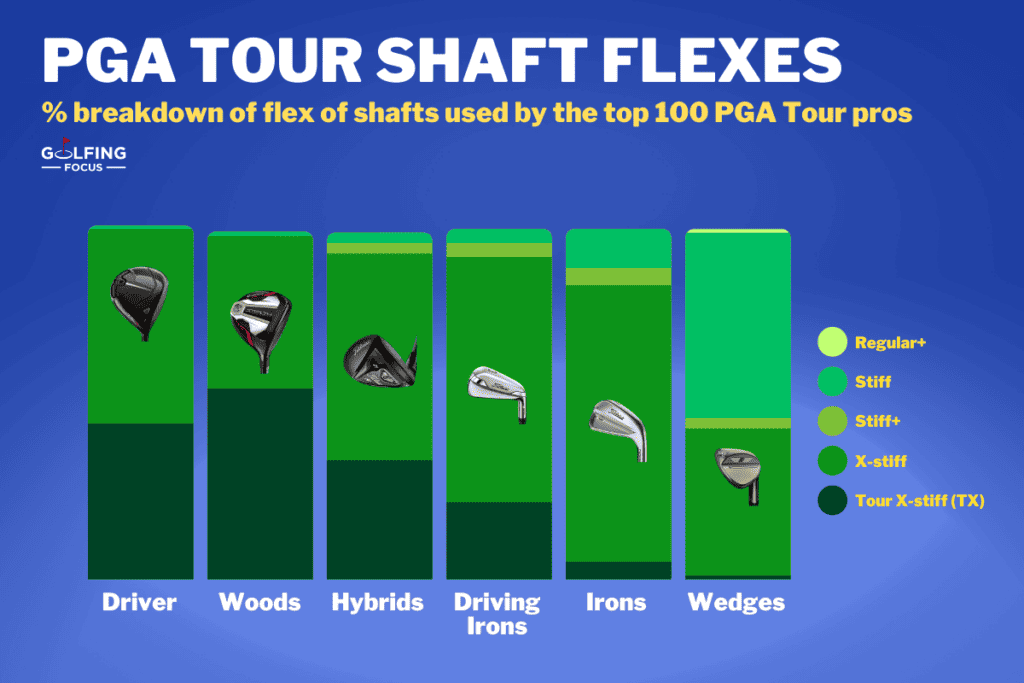
What Flex of Shaft Do Pros Use? Shorter Clubs Are a Little Softer
Golf shaft manufacturers don’t make it very straightforward to compare shaft flexes.
While some of them use labelling which is easy to understand – regular shafts are ‘R’, stiff shafts are ‘S’, extra stiff shafts are ‘X’, and tour extra stiff shafts are ‘TX’ – others categorise the flex differently and use a numbering system which is not always easy to understand.
True Temper for example uses a numbering system which not only varies between shafts for woods and irons but also varies between different models of shafts they make!
This makes the job of comparing what shafts the different pros use more complicated but whatever the system it is clear the debate for the top pros is not the regular vs. stiff shaft flex one that it is for many amateurs.
Across the driver, wood, hybrid, driving iron, iron and wedge shafts used by the top 100 PGA Tour pros 18.6% are tour extra stiff flex. 49.7% are extra stiff flex with 27.6% being of stiff or wedge flex. 2.1% of the shafts are stiff+ flex while only 0.3% are regular+ flex. None of this group uses a regular shaft in any club.

With close to 70% of all the shafts played by the top 100 PGA Tour pros being either of TX or X-stiff flex, and 99% of them being of stiff flex or stronger, the preferences of most of the best players in the world are clear when it comes to what flex of shaft they use.
As we look in more detail at the flex of shafts they choose in the different club types however we do start to see a more varied picture.
With their drivers for example 55% of the top 100 PGA Tour pros use an extra-stiff shaft with another 44 choosing an even stronger Tour extra stiff or TX flex shaft.
And as we have already noted the only outlier when it comes to flex of driver shaft among this group is the 2023 British Open champion Brian Harman who still uses ‘only’ a stiff shaft in his 9º Titleist TSi2 driver.
This 99% of the top 100 Tour using either extra stiff or Tour extra stiff flex driver shafts in 2023 is also up from the 90% figure we noted when we last did this analysis two years ago.
It therefore seems that the top players’ relentless quest for ever more distance off the tee is impacting on their driver shaft choices.
This preference for very strong flex shafts in the longest clubs in the pros bag is again in evidence when it comes to their fairway woods, hybrids and driving/utility irons.
For fairway woods for example over 95% of the shafts chosen by the top 100 PGA players are TX or X-stiff flex while for hybrids that percentage drops only slightly to 88%.
When it comes to driving or utility irons however the proportion of top 100 pros using X-stiff or TX shafts is back up to 92%.
The remaining players in each of these club categories choose either a stiff or stiff plus (stiff+) flex shafts including Brian Harman once again, Kevin Kisner, Troy Merritt, Luke List and CT Pan.
Not one of this elite group however is using a regular shaft in any of these club types.
As the clubs get shorter however things do start to change slightly.
As we started to look at the flex of shafts the top 100 use in their irons we noticed the shaft flex picture start to ‘soften’ slightly.
11% of the top 100 PGA Tour pros use stiff shafts in their standard irons including Hideki Matsuyama, Corey Connors and Brian Harman. 5% choose stiff+ iron shafts, a flex in-between stiff and extra stiff, although 78% use extra stiff shafts with another 5% choosing extra stiff iron shafts.
Again not one of the top 100 uses regular flex irons shafts.
It is only among the wedge shafts selected by the pros that you finally see the majority of them using ‘softer’ flex shafts.
But as we can see below a healthy number still continue to choose extra stiff shafts even in their wedges.
[Note – To find out whether the pros use graphite or steel shafts check out our great article on this topic here .]
Do Any Pros Use Regular Shafts? Only in Their Wedges!
When it comes to the shafts the best pros use many players will choose shafts made by 3 or even 4 different shaft manufacturers.
The majority also vary the flex of shafts these use across the different club types.
What many amateurs want to know typically is whether any pros use regular or stiff shafts as that is main question the average player is wrestling with when putting together their own set.
As we have already noted however when it comes to the flex of the shafts the top 100 PGA Tour pros use softer flex shafts like ‘regular’ shafts simply don’t figure and one of the main reasons for this swingspeed.
With an average driver swingspeed on the PGA Tour of around 115mph very stiff shafts are required to produce the results the pros want.
Too ‘soft’ and the shaft would simply bend too much based on the ‘load’ the best players apply to the shaft.
When it comes to their wedges however even the the pros start finally to opt more often for slightly softer flex shafts.
That does not mean though that the vast majority opt for anything any less strong than a stiff shaft.
Stiff shafts are the clear preference when it comes to wedge shafts, however compared to the extra stiff and tour extra stiff shafts they prefer in other clubs, 53% of the top 100 PGA Tour pros opt for stiff shafts in their pitching, gap, sand and lob wedges.
And when you remove pitching wedges from the equation the number of this elite group using stiff wedge shafts rises again to 62% highlighting again that the pros choice of flex gets progressively ‘softer’ as their clubs get shorter and more lofted.
Saying that however over 40% of this elite group still use extra stiff shafts in the shortest clubs in their bag and we found Matthew NeSmith as the sole user of regular+ flex shafts in his Cleveland RTX Zipcore Tour Rack gap, sand and lob wedges.

Do All Pros Use Extra Stiff Shafts? In Their Longest Clubs They Do!
When it comes to looking at the flex of shafts the pros use in their clubs discussion often starts with the driver.
Golfers are most often concerned with shaft flex when it comes to the club they can hit the ball furthest with.
And when it comes to driver shafts the preferences of the best players on the PGA Tour are crystal clear.
In 2023 99% of the top 100 PGA Tour pros use either an extra stiff or Tour extra flex driver shaft. 44% choose a Tour extra stiff or TX driver shaft including Justin Thomas and Jon Rahm. 55% use extra stiff shafts including Rory McIlroy while Brian Harman is alone among this elite group in using a stiff driver shaft.
Again as we have already noted not one of the top 100 uses a regular or regular+ shaft in their driver.
And once again the simple reason for this is swing speed.
Shaft flex is in short a measure of how much a shaft will bend under the force of a golf swing with a head attached at the tip end.
As a shaft bends during the loading and downswing, so does the head rotate through the swing.
Choosing the proper flex allows the head to come back to the square position, thereby transferring the maximum amount of energy to the ball at impact.
The speed and frequency of your swing therefore determines what flex you need and one of the key reasons PGA Tour pros are able to achieve an average driving distance of close to 300 yards is because their average driver swingspeed is now over 115mph.
Brandon Matthews meanwhile tops the latest driver swingspeed chart with an incredible average of 126.51mph over the course of the 2023 season.
Such swing speeds create a lot of bend in golf shafts and therefore the pros need a very stiff driver shaft to deliver the best results.
Of the 72 different individual driver shafts being used by the top 100 PGA Tour players made by eight different manufacturers we found Fujikura’s Ventus Black 6X was the most popular extra stiff shaft.
Meanwhile Mitsubishi’s Diamana range of driver shafts were shown to be the most used ‘Tour’ extra stiff flex shafts.
And this requirement for extra stiff shafts is also clearly in evidence in the other clubs the pros are aiming to hit consistently as far as possible – namely their fairway woods and hybrids.
As a general rule all the pros use tour extra stiff or extra stiff flex shafts in their fairway woods and hybrids.
Out of the top 100 PGA Tour pros only Brian Harman uses a stiff shaft in his Titleist TSi2 3-wood and Titleist TS2 5-wood.
And Kevin Kisner’s and Troy Merritt’s choices of a stiff and stiff+ shaft respectively in their hybrids again put then very much in a minority when it comes to the shaft flex choices of the best players on tour for these club types.

And what about the great Tiger Woods?
Well before his latest injury troubles he was also seen to be playing tour extra stiff shafts in his driver and fairway woods at the 2023 Masters.
He did however opt for comparatively ‘softer’ extra stiff shafts in his irons and pitching wedge before switching down flex again to only a stiff flex for his sand and gap wedges.
A complete list of the shaft flexes used by Tiger is shown in the table below.
[Note – To check out the details of the exact shafts being used by the top 100 PGA Tour pros, including the most popular models across all categories of clubs, click here .]
Before you go …
Knowing what flex of shafts the top pros are choosing for their clubs is always interesting and fun to look into.
But with average driver swingspeeds over 20mph faster than the average amateur golfer (115mph vs. 93.4mph) there is probably more to learn from the iron shafts being used by the best female pros.
Read our next article to find out what iron shafts and irons the best LPGA pros are choosing with their 94mph average swingspeeds …
What Irons and Iron Shafts Do LPGA Players Use?
[Note – Just so you know, and we are upfront as an affiliate program participant, Golfing Focus, at no cost to you, earns from qualifying purchases made through links on this page.]
Other great articles related to this topic:
- Flexible Friends: Uncovering The Shafts Champions Tour Players Use
- Do Pros Use Graphite or Steel Shafts? It Depends Which Club
- What Shafts Do Pros Use? Top 100 PGA Tour Player Breakdown
- What Driver is Most Used On the PGA Tour? Top 100 Player Analysis
- The Fairway Woods Used by the Top 100 PGA Tour Pros
- What Hybrid Golf Clubs Do the Top 100 PGA Tour Pros Use?
- What Driving Irons do the Pros Use on the PGA Tour?
- What Irons Do the Pros Use? Top 100 PGA Tour Player Guide
- What Wedges Do the Pros Use? Top 100 PGA Tour Player Analysis
- What Putters do the Pros Use? Top 100 PGA Tour Player Guide
- What Golf Balls Do the Pros Use? Top 100 PGA Tour Players Breakdown
- What Golf Grips Do the Pros Use? Top 100 PGA Tour Player Guide
- What Clubs Do Pro Golfers Use? Top 100 PGA Tour Player Guide
- What Clubs do LPGA players Use?
Leave a Reply Cancel reply
Your email address will not be published. Required fields are marked *
Save my name, email, and website in this browser for the next time I comment.
RECENT ARTICLES

Champions Hybrid Heroes. Most Used Hybrids by Champions Tour Pros (2024)

The Go-To Fairway Woods of Senior Tour Champions (2024)

Flexible Friends: Uncovering the Shafts Champions Tour Players Use (2024)

In the Bag: Unpacking the Clubs Champions Tour Players Use (2024)

Champions’ Choice: The Most Used Irons on the Champions Tour (2024)
LEGAL INFORMATION
This site is owned and operated by Golfing Focus Limited, a private limited company whose registered office is in London, UK. Golfing Focus Limited is a participant in the Amazon Services LLC Associates Program, an affiliate advertising program designed to provide a means for sites to earn advertising fees (at no cost to you) by linking to Amazon.com. Golfing Focus Limited also participates in other affiliate programs with the eBay Partner Network, FlexOffers, CJ.com, Svorn and other sites and is compensated for referring traffic and business to these companies (again at no cost to you).
Our Socials
- Fairway Woods
- Golf Accessories
Stiff Flex vs. Regular Flex: In-detail Comparison
One of the most challenging aspects of golf equipment shopping is finding the right clubs. This is especially true if you’re not armed with the correct information. Keep in mind that you can’t adopt a one-size-fits-all approach because you need to find a club that accurately fits your swing. You could go to a professional fitter, but even then, you’ll need to understand some variables such as the right kind of flex for you.
If you’re facing the stiff flex vs. regular flex dilemma, this article highlights everything you need to know about which option you should go for. This includes the advantages and drawbacks of each option as well as a quick comparison. Let’s dive in!
Golf Club Shaft Basics

If you go for a shaft that is too flexible and light, you may end up overpowering the club. This increases your chances of missing and makes it difficult to control the club. On the other hand, if you go for a stiff and heavy shaft, your swing will be slower. Causing you to make misses low and right.
Here’s a quick overview of both stiff and regular flex.
- What Is Stiff Flex?
A stiff flex is a bit heavy, and it adds resistance to your swing. So, when you try hitting the golf ball with a lot of speed, you’re able to achieve more distance. These types of shafts will be perfect for you if your swing speed hits about 100 mph. If you don’t know your swing speed, you can easily determine it by using a rangefinder, some of which cost below $100 .
According to popular reviews, one of the best stiff flex for high handicappers is the Callaway Steelhead XR Fairway Wood Golf Club . It features a versatile head that’s easy to launch and has a beautiful yet functional design that allows you to make fast swings.
Alternatively, you can choose any Cobra Fairway Woods as they come highly recommended. They’re available in multiple designs and flexes, ensuring that you get a shaft that suits your gameplay.
- What Is Regular Flex?
Regular flex is a great option for golfers that have a slower swing of 90 mph or less. It’s light and therefore more flexible. It allows you to achieve high club speeds on your downswings, allowing you to achieve more distance. Due to their design, regular flex shafts allow you to hit the golf ball at a fast pace and on a higher trajectory.
Who and When Should Use Stiff Flex?

Stiff shafts are common among PGA Tour professionals.
Some of the benefits of using a stiff shaft include;
- Great results for players with fast swing tempos
- Increased control and accuracy
- Better short game control
- Reduces dispersion
If you go for a stiff shaft even though your swing speed is low, you’ll limit your shot trajectory and carry distance. It will also result in slices or fades.
Who and When Should Use Regular Flex?

Based on an article by the BBC , the number of golf players is steadily increasing, and in the UK alone, there was a 2.1 million player increase. If you’re new to the game, make sure you start with softer shafts, as they’ll help you increase your speed.
The main benefits of flexible shafts include;
- Higher efficiency
- They’re easily affected by vibrations
- They eliminate alignment problems
- They allow for larger bending offsets
Perhaps the main disadvantage of flexible shafts is that even though they allow you to hit longer distances, you have to compromise on control and accuracy. This is because it’s difficult to control the impact of the clubface when the shaft is that soft. As a beginner, your primary focus should mostly be on accuracy, so this can be a huge inconvenience.
Quick Comparison
According to CNN , one of the key aspects of improving your game is analyzing your swing, and this is highly influenced by the flex you go for. This will help you increase your potential shot distance and optimize your accuracy. If you go with a flex that is too stiff, your distance will reduce. On the other hand, if you go for a regular flex iron when you are best suited for a stiff one, you’ll experience a lot of inconsistencies in ball flight.
Here’s how the stiff flex vs. regular flex compare.
As you choose between regular and stiff flex, there are other factors that come into play
- Shaft Material
Some materials change the performance of your club. For instance, if you go for a stiff flex that has a graphite shaft, its performance will almost be similar to that of a regular shaft made of steel. Since graphite is lightweight, it will make the club very easy to swing. If you’re unsure of the material you should choose for your club, experiment with different materials and then stick to the one that suits your needs best.
- Distance or Accuracy
The driver’s carry distance should help you determine the best flex. For instance, if your distance is between 240 and 260 yards, you should go for a stiff flex. If it ranges between 210 and 240 yards, then a regular flex would be the best fit.
Other factors that you should consider include;
- Brand: a standard flex doesn’t exist, so what one brand may consider as stiff flex could be regular in another brand. This is why you should test several pieces of equipment before you make a purchase.
- Weight: generally, stiff shafts tend to feel heavy. So if your regular shaft feels a bit heavy, it could provide the same performance as a stiff shaft.
- Final Thoughts
Between stiff flex vs. regular flex, which one should you go for? Well, the purchase decision should be based on your swing and experience levels. Beginners typically use regular flex as they’re easy to control, while experts tend to lean more towards stiff flex for accuracy. You should also consider the material of the shaft. If it’s graphite, it will perform similarly to regular flex. On the other hand, if a regular flex feels a bit heavy, it will perform the same as a stiff s flex. These disparities occur because there isn’t a standard flex, so you have to test out various clubs to find the one that’s best for you.
Your email address will not be published. Required fields are marked *
Save my name, email, and website in this browser for the next time I comment.
Post Comment
- 1 5 wood vs 3 hybrid
- 2 6 iron vs 6 hybrid
- 3 5 wood vs 3 iron
- 4 how to clean golf grips
- 5 how to remove a superstroke putter grip

Stiff vs. Regular Flex: Which Shaft Is Right For Your Game?

- Last Updated on October 8, 2022
Do you want more distance, better ball flight, and improved accuracy for your golf game?
Then it’s time to ensure you are swinging the right shaft flex. While a lot of golfers worry about graphite vs. steel shafts, shaft flex is incredibly important too.
In fact, a lot of professional fitters and high-level golfers would argue that shaft flex is more important than the clubs themselves. For most everyday golfers, this means deciding on stiff vs. regular flex shafts .
Some golfers will benefit from regular flex, while others will benefit from stiff shafts. Ultimately, it comes down to one number to measure your swing and use the right equipment.
Today, you will learn how to find the right shaft based on data instead of taking an educated guess. Having the right shaft flex can lead to better ball striking overnight.
Stiff vs Regular Flex in Golf Clubs
If you’re like most golfers, you’ve probably wondered… “Should I play regular or stiff flex golf clubs?”
If you haven’t asked yourself that yet… you need to ASAP. Playing shafts that match your swing is one of the few things you can do that will lead to instant improvement.
While most clubheads and training aids promise to fix your swing issues, shafts actually have that potential. While it’s not to say that shafts will fix all your swing flaws, they can lead to more distance, better accuracy, and better trajectory.
Here’s how to make this complex decision easy.

Finding the Right Shaft Flex
When it comes to picking the right shaft flex, one piece of swing data matters above all else – clubhead speed . Thanks to the help of launch monitors, it’s easier than ever to find the right flex for your golf swing.
Shaft flexes are based on swing speed with your driver.
Swing speed is the biggest factor, not age, handicap, years of experience, or what shafts you’ve played in the past. Too many golfers make the mistake of thinking , “I’m 60 years old so I should play a senior flex shaft.” Or, “I’m a beginner so I should play a regular flex shaft.”
While both of those instances might be true, clubhead speed is much more important. Because 60-year-old players can still swing at regular or stiff flex speeds. And beginners who have athletic backgrounds might need stiff flex shafts, even in their starter set.
Also Read: How To Clean Golf Clubs
Here are the different flexes recommended based on your average clubhead speed:
- Ladies flex = >72 mph
- Senior flex = 72-83 mph
- Regular flex = 84-96 mph
- Stiff flex = 97-104 mph
- Extra stiff flex = 104-115 mph
- Tour stiff flex = 115mph+
The faster you swing the golf club, the more flex you need. The majority of recreational golfers need a stiff or regular flex as most golfers swing between 84-104 mph.
💥 Don’t Miss These Deals 💥

- Pwr-cor technology
- Hot face-highly optimized technology
- Cnc milled infinity face
- Multi-material chassis
- Adjustable weighting

- Increased sole curvature assists with turf interaction
- Multi-material cap back design
- Designed to maximize distance, forgiveness and feel
- Postioned inside the iron head

- True Path Alignment System
- Increased Stability
- Improved putting accuracy
- Optimal stability and alignment
Stiff vs. Regular Flex
Choosing flex for ladies and Tour players is pretty easy. But for most golfers, it’s harder to decide senior vs. regular vs. stiff flex shafts.
Before buying any new shafts or golf clubs, head to your golf store (or use a personal launch monitor) to evaluate your swing speed. Once you have a good sample size (about 20 driver swings), calculate the average to find your “normal” swing speed.
This will determine if you need senior, regular, or stiff flex. Then, make sure your shafts in your woods, hybrids, and irons all have that flex.
Here’s why it’s so important to play the right flex and not “guess” on your equipment.
Playing a Shaft that is Too Stiff
A lot of golfers let ego get in the way and think they swing faster than they actually do. This can lead to using stiff shafts instead of regular flex which might have a negative impact on your game.
According to Bombtech Golf , “The most common mistake is playing a golf shaft that is too stiff. If you are playing a golf shaft that is too stiff for your swing speed or golf mechanics, you may experience the following.
- Lower ball flight which leads to less distance.
- A fade or leaking ball flight. This occurs because the golfer cannot flex the golf shaft enough to create a square impact position.
- It won’t feel great even on center hits.”
As you can tell, this small mistake can have an enormous impact on your ball striking. This is why it’s so important to calculate your swing speed instead of guessing.
Playing a Shaft with too Much Flex
Another common scenario among amateur golfers is playing clubs that have too much flex. A good example would be a player with a 100mph driver speed and using regular flex shafts instead of stiff shafts.
Based on the same Bombtech article, “If you are playing a golf shaft that is too flexible, you may experience the following (less common)
- Higher ball flight, regardless of loft which can result in less distance. Which for many golfers is needed.
- A draw or slightly hooking ball flight. More forward bend of the shaft at impact can cause the face to rotate past square and become closed.
- Better feel and solid contact.”
The article elaborated and said that it’s better to play a softer flex instead of a shaft that is too stiff.
However, if you are actively speed training and working on increasing your swing speed, you might want to wait to buy shafts.
Related : How to increase Swing Speed
Play the Same Flex in All Golf Clubs
Finally, I think it’s important to note that you should play the same flex in all of your golf clubs. While you don’t need the exact same type of shaft or same weight in your driver, woods, and irons, you should play the same flex.
Here’s why…
If you play a regular flex in some golf clubs and stiff flex in others, you will have different misses. You won’t have a consistent miss and it can make it hard to figure out if you have a swing flaw or a shaft issues.
For example, with two different shafts one miss might be low and to the left. While a club with a different shaft might miss high and right. Having a two-way miss makes golf hard and very challenging to manage your mistakes.
Once you find out if stiff or regular flex is best, swing that shaft in all your golf clubs.
The only exception is your wedge shaft flex as it’s okay to play a slightly different shaft with more flex. Since you don’t swing wedges with high speed, less flex can improve performance.
In fact, a lot of golf club manufacturers don’t even offer different shaft options. Titleist’s wildly popular Vokey wedges are a great example as they’re only available in a “wedge flex.” While you can pay extra to get shafts that match your irons, it’s not necessary for the majority of golfers.
Related : Golf Wedge Buying Guide
Should You Get Fit for Golf Clubs?
It’s easy to think that club fitting sessions are only for more advanced golfers. But this couldn’t be further from the truth.
When asked, “Who should get fit for golf clubs” Club Champion answered – everyone .
Further, elaborating with, “All ages, all skill levels, doesn’t matter. In fact, we’ve found that the higher your handicap, the more measurable improvement can be seen in our fitting bays and out on the course. Having the proper shaft flex, weight, profile and length coupled with the right swingweight, lie, loft and grip can all help you reach your golf goals.”
Higher handicap golfers, especially those that are actively improving, will benefit the most from a proper fitting session. Getting fit with an expert can help you find the right flex and test out different shafts to see how they affect distance, spin, trajectory, and accuracy.
Plus, you can also find the right length and lie for your irons and wedges. For a small fee, it’s one of the best investments you can make in your golf game.
Top Questions About Shaft Flex
Do you have more questions about swinging the right flex in your golf clubs? If so, keep reading to ensure your shafts match your swing speed for optimal results on the golf course.
Is there a big difference between stiff and regular flex?
Yes, there is a big difference between stiff and regular flex shafts. As discussed above, clubs with too much flex or not enough flex can impact distance, shot dispersion, spin, and ball flight.
Will I lose distance with a stiff shaft?
If you don’t have a high enough swing speed, you can lose distance with each club in the bag. However, if you have enough clubhead speed, you could actually gain distance with stiffer shafts. Not to mention, the right shaft can improve your accuracy and minimize those big misses.
For example, I have a friend with a baseball background and swings the club extremely fast, despite only playing 1-2 times per month. When he swapped regular for stiff shafts, his big misses went from off the golf course to ending up in the right rough.
Is stiff flex harder to hit?
Stiff flex shafts are harder to hit if you don’t have enough swing speed. However, if you have a higher than normal swing speed, they’re a great option and will actually improve your ball striking.
Can a high handicapper use stiff shafts?
A high handicapper should generally avoid stiff shafts. Beginner players or golfers who don’t get to the course as would often benefit from senior or regular flex shafts.
But it ultimately depends on one thing – swing speed . Some golfers might be classified as “beginners” but have a ton of speed and need to use stiff shafts. That’s why it’s important to always check your speed using a launch monitor instead of guessing the right shaft flex.
Will a stiffer shaft lead to lower ball flight?
Yes, stiffer shafts can lead to lower ball flights.
Golfers who play regular flex shafts but swing at 100mph will have a high ball flight that isn’t penetrating and can hurt distance. Swapping to a stiffer shaft can instantly improve trajectory and make it a much more piercing ball flight.
Additionally, shaft weight also plays a big role in trajectory and shot dispersion as well. Lighter shafts tend to go higher than heavier shafts and also amplify your misses. So if you want to hit more fairways and keep it under the wind, a heavier shaft might be just what you need.
What if I’m between stiff and regular shafts?
This is a good question as you don’t want to buy the wrong shafts and have to replace them as they’re not cheap. Let’s say you swing at 94 mph, which is the high end of a regular flex shaft but close to stiff (only 2mph away).
For most golfers, you would benefit from using a softer shaft. It’s much better to play shafts that are too soft vs. ones that are too stiff.
However, if you’re playing more often, practicing regularly, and/or speed training, it might make sense to buy stiff shafts. This way you won’t need to replace them in the near future.
Wrapping Up
One of the most important things you can do is swing the right shafts. Because even if you love your driver, woods, and irons, without the right shaft flex the clubs won’t perform their best.
Golf has so many variables and tons of them we can’t control (weather, course layout, etc.). But one thing that is 100% in your control is buying the right shaft.
Switching to regular or stiff shafts based on your swing speed can lead to overnight changes to your game. While they won’t hide swing flaws, the right shaft can improve ball flight, increase distance, and hopefully minimize your misses.
Have you made the switch to regular from stiff (or stiff to regular)? If so, how did it impact your ball striking?
Let us know in the comments below.

Michael Leonard
Michael Leonard is a full-time writer, author, creator of Wicked Smart Golf and +1 handicap amateur golfer. He left his corporate career in 2017 to pursue entrepreneurship and professional golf; since then, he’s competed in 160+ tournament days and went to Q-school in 2019.
You May Also Like

How To Clean Golf Clubs: [Our Top Tips For Looking After Your Clubs]

Best Golf Clubs for Seniors 2023: Our Top Picks To Help Your Game

How To Measure Putter Length & Why It’s Important

5 Wood vs. 3 Hybrid: Settling the Fairway Wood Hybrids Debate

Small Head Drivers: Do You Need One?

PXG Fitting Review
Leave a comment cancel reply.
Save my name, email, and website in this browser for the next time I comment.
- What's Albatross Club?

- Search forums
Follow along with the video below to see how to install our site as a web app on your home screen.
Note: This feature currently requires accessing the site using the built-in Safari browser.
Tour Stiff vs Stiff - What's the Difference?
- Latest Posts
- Recent Activity
- All Things Equipment
- Shafts, Grips & Club Fitting

Reframmellator
Well-known member.

- Mar 12, 2018
I was browsing Mitsubishi Kuro Kage Black Dual-Core TiNi 60 shafts as a potential replacement for the Rogue MAX in my 3 wood. This is based on how happy I am with that shaft, in stiff flex, in my driver. I noticed a lot of new versions available from $70-100, but they are listed as "Tour Stiff." "Standard" stiff versions are $200-250. I realize shaft terminology varies among manufacturers, and sometimes within a manufacturer's product lines. Any thoughts/experiences on this, especially as it refers to the KK line, are much appreciated.
- Thread starter
The TS-flex will play in between a S-flex and an X-flex. If you need a little bit more stability than your S-flex is offering the TS-flex would be a good option for you Click to expand...
The Dual Core TS is the same profile and materials as the Dual Core Stiff. It is a mid launch low-mid spin shaft. The TS’s flex lands perfectly between Stiff and X-Stiff.
- Style chooser
- Nighttime Golfing
- Change width
- Terms and rules
- Privacy policy

Green Valley Ccofri
tour flex vs stiff flex
For many golfers, choosing the right shaft flex can be a difficult decision. Tour flex and stiff flex are two of the most popular options. Tour flex is designed to provide maximum control and accuracy for the more experienced players, while stiff flex offers extra power for those who can generate higher swing speeds. In this article, we’ll compare tour flex vs stiff flex so you can make an informed decision on which one is best for your game.The main difference between a tour flex and a stiff flex golf shaft is the amount of bending the shaft will experience during the swing. Tour flex shafts are designed to allow for more movement in the lower half of the swing, while stiff flex shafts are designed to be more stiff and less flexible throughout the entire swing. Generally speaking, tour flex shafts provide more feel and feedback to the golfer, while stiff flex shafts provide more control and accuracy. In general, a golfer with faster swing speeds will benefit from a stiffer flex shaft, while slower swing speeds should opt for a softer or tour flex shaft.
Table of Contents
Tour Flex vs Stiff Flex: Pros and Cons
When choosing a golf club, one of the most important decisions is deciding between a tour flex or stiff flex shaft. Tour flex shafts are typically lighter and more flexible, while stiff flex shafts are heavier and less flexible. Each type of shaft has its own advantages and disadvantages, which should be considered when making your selection. Below we will look at the pros and cons of tour flex versus stiff flex shafts.
Pros of Tour Flex Shafts
The main advantage of tour flex shafts is that they provide increased clubhead speed. This increased speed helps to generate greater distance off the tee. Furthermore, tour flex shafts have more feel than stiffer shafts, allowing for more precise control over shots. This can help improve accuracy on approach shots and putts.
Cons of Tour Flex Shafts
The main disadvantage of tour flex shafts is that they can be difficult to control for slower swing speeds. The extra flexibility can make it difficult to square the clubface at impact, resulting in slices or hooks with off-center hits. Additionally, because tour flex shafts are lighter than stiffer ones, they may not provide enough stability for some players.
Pros of Stiff Flex Shafts
The primary advantage of stiffer shafts is that they provide greater stability on shots hit off-center. The added stiffness helps to square the face at impact, resulting in straighter shots even when you don’t make perfect contact with the ball. Additionally, because these shafts are heavier than tour models, they can help increase clubhead speed for players with slower swing speeds.
Golfers of all levels often struggle to decide which golf shaft flex is right for their game. Tour flex and stiff flex are two of the most popular options, and both offer unique benefits. The right choice for you depends on your individual game and skill level.
When deciding between tour flex and stiff flex, it’s important to understand the differences between the two. Tour flex golf shafts are designed to provide a softer feel and more control over shots while still allowing for a powerful swing. They are typically lighter than stiff shafts, which helps to create a smoother swing. Tour flex shafts also have less side spin, meaning shots will stay straighter even with a slight mis-hit.
Stiff flex golf shafts are heavier than tour shafts and provide more power during your swing. They also allow for more control over shots, but they may not be as forgiving as tour flex when it comes to mis-hits. Stiffer shafts can also produce higher ball flights, making them better suited for players who like to hit their tee shots high in the air.
The type of golf club you use can also affect your decision between tour flex and stiff flex. Generally speaking, drivers and woods should be fitted with stiffer shafts while irons should be fitted with tour flex ones. This is because drivers and woods require more power during your swing compared to irons, which require more accuracy and control off the tee or fairway.
The best way to decide between tour flex vs stiff flex is by testing both out on the course or range before making a final decision. It may take some trial and error before you find the perfect combination of club head, loft angle, club length, grip size, and shaft flexibility that works best for your individual game. Once you have found what works best for you, stick with it as much as possible!
How to Choose Between Tour Flex and Stiff Flex Shafts
When it comes to golf clubs, choosing the right shaft flex can be just as important as selecting the right club head. Golfers know that having the correct shaft flex can make a huge difference in their game. Tour flex and stiff flex shafts are two of the most popular types used in golf clubs, so how do you decide between them? Here are some tips to help you figure out which type of shaft is best for you.
The first thing to consider when deciding between tour flex and stiff flex shafts is your personal swing speed. Generally speaking, a golfer with a slower swing speed should opt for a tour flex shaft, while a golfer with a faster swing speed should choose a stiffer shaft. If you’re unsure of your swing speed, many golf courses offer testing services that can give you an accurate measurement.
It’s also important to consider your skill level when selecting between tour flex and stiff flex shafts. For golfers who are relatively new to the game or for those who don’t have very good accuracy yet, tour flex shafts tend to be easier to control and provide better feedback on shots. On the other hand, more experienced players may find that stiffer shafts provide more power and accuracy on their shots.
Finally, it’s important to take into account your own personal preferences when choosing between tour flex and stiff flex shafts. Some golfers prefer the feel of one type over the other; for example, some may find that tour flex shafts provide more “feel” than stiffer ones while others may find they have better control with a stiffer shaft. Experimenting with different types of clubs is one of the best ways to figure out which type works best for you.
In conclusion, choosing between tour flex and stiff flex shafts depends largely on your personal swing speed, skill level, and preferences. Take all these factors into consideration when selecting clubs so that you can get the most out of your game!
Tour Flex and Stiff Flex
There are two main types of golf shafts: tour flex and stiff flex. Deciding between the two can be a challenge because they both have benefits and drawbacks. To help you make the best decision, here are some factors to consider when deciding between tour flex and stiff flex.
The first factor to consider is your swing speed. Tour flex shafts are designed for players with slower swing speeds, as they provide more control over the shot. Stiff flex shafts, on the other hand, are designed for players with faster swing speeds, as they provide more power and distance. If you’re unsure of your swing speed, you can get a professional fitting to help make the best decision.
Another factor to consider is your level of accuracy. Tour flex shafts provide more control over the shot, which is helpful for players who need more accuracy off the tee or in tight situations around the green. Stiffer flex shafts may be better suited for players with higher levels of accuracy who don’t need as much control over their shots.
Finally, consider your overall goals for playing golf. If you’re looking to improve your game and increase your distance off the tee, then a stiffer shaft may be better suited for you. If you’re looking to improve your accuracy around the green or in tight situations, then a tour flex shaft may be a better choice.
Ultimately, deciding between tour flex and stiff flex comes down to personal preference and what works best for your game. It’s important to take all of these factors into consideration when making your decision so that you can get the most out of your clubs and play at your best each time you step on the course
Comparing Swing Speed for Tour Flex and Stiff Shafts
The golf shaft is an integral part of the overall club design, and the flex of the shaft can significantly affect the swing speed. Tour Flex shafts are designed to provide maximum stiffness for increased ball speed, while Stiff shafts are designed to provide more control at the expense of some ball speed. It is important to understand the differences between these two types of shafts in order to determine which one will be most beneficial for your game.
The flex of a shaft is determined by its flex rating, which is measured by how much force it takes to bend the shaft a certain amount. Tour Flex shafts typically have a flex rating between 2.5 and 3.0, while Stiff shafts have a rating between 3.5 and 4.0. The stiffer a shaft is, the more power it will generate on impact, but this also makes it more difficult to control shots with accuracy and consistency.
When comparing swing speed for Tour Flex and Stiff Shafts, it is important to consider both ball speed and shot accuracy. Generally speaking, Tour Flex shafts will generate higher ball speeds due to their increased stiffness, but this may come at the expense of some control over shot accuracy and distance off the tee. Conversely, Stiff shafts will generate less ball speed but provide more control over shot accuracy and distance off the tee.
It is important to note that different players may benefit from different combinations of stiffness and spin rate depending on their individual swing style and preferences. For example, players who prefer more spin on their shots may benefit from softer Tour Flex or even Senior Flex options whereas those who prefer less spin may benefit from stiffer options such as Extra-Stiff or X-Stiff Shafts. Ultimately, each player should experiment with different combinations of swing speeds in order to find which one works best for them individually.
Overall, understanding the differences between Tour Flex and Stiff Shafts can help players make better decisions when selecting golf clubs that will help them achieve their desired results on the course. Additionally, experimenting with different combinations of swing speeds can give players an idea as to which combination works best for them individually so they can achieve optimum performance in their golf game.
Comparing Head Speed for Tour Flex and Stiff Shafts
Head speed is a crucial factor when it comes to golf clubs. The more head speed you generate, the further your shots will travel. Tour flex and stiff shafts are two types of shafts available in the market that can help you achieve increased head speed. Both these shafts have their own pros and cons, so it is important to understand which one is best suited for your game.
Tour flex shafts are designed to help golfers generate more head speed with a lower effort level. They have a flexible tip section that allows for increased launch angle and spin rate. This added loft helps golfers hit the ball further and straighter off the tee box. The downside of tour flex shafts is that they can be harder to control, which may lead to some shots going off target.
Stiff shafts are designed for more experienced players who are able to generate enough head speed without having to sacrifice accuracy or control. These shafts are typically heavier than tour flex shafts, which helps create more stability and consistency during swings. The downside of stiff shafts is that they require more effort to generate head speed, which could lead to fatigue if used improperly or too often.
Ultimately, it is up to the golfer to decide which type of shaft works best for their game. If you struggle with generating enough head speed or controlling your shots, a tour flex shaft may be the best option for you. On the other hand, if you already generate good head speed but want more control over your shots, then a stiffer shaft may be what you need.
Comparing Launch Angle for Tour Flex and Stiff Shafts
The launch angle is an important factor when choosing the right golf shaft. Tour flex and stiff shafts are two of the most popular types of golf shafts available. Tour flex shafts are designed to provide more control over the ball, while stiff shafts provide more power and distance. Comparing launch angle for these two types of shafts can help golfers decide which type is best suited for their game.
The launch angle is determined by a number of factors such as clubhead speed, spin rate, and environmental conditions. Tour flex shafts tend to have lower launch angles than stiffer shafts due to their flexibility. This allows the golfer to control the trajectory of the ball more precisely, resulting in a lower launch angle. Stiffer shafts on the other hand, generate more power and distance due to their stiffness. This increases the loft of the ball resulting in a higher launch angle.
It is also important to consider other factors when comparing launch angles between tour flex and stiff shafts. For example, clubhead speed will have an effect on the launch angle, as faster clubhead speeds tend to create higher launch angles than slower speeds. Spin rate also plays a role in how high or low a ball will travel; high spin rates can create lower launch angles while low spin rates can lead to higher launches.
Ultimately, it is up to the individual golfer to decide which type of golf shaft is best suited for their game based on their needs and preferences. Comparing launch angles between tour flex and stiffer shafts can help them make an informed decision about which type of golf club suits them best.
When it comes to choosing between a stiff flex and a tour flex golf shaft, the decision comes down to personal preference and the type of player you are. Stiff flex shafts are best suited for advanced players who have a faster swing speed and generate more power, whereas tour flex shafts are better suited for slower swing speeds. If you’re unsure which option is right for you, don’t be afraid to consult with your local golf professional or club fitter. They can help you make an informed decision that is tailored to your specific needs.
Regardless of which type of shaft you choose, remember that the key is consistency. Once you have determined which type of shaft suits your game best, focus on creating a consistent swing with it and strive to hit each shot with the same level of power and accuracy. With enough practice, you’ll be able to maximize the potential of both tour flex and stiff flex shafts.

- Remember me Not recommended on shared computers
Forgot your password?
- WRX Club Techs
Ping Tour Shafts Flex - Stiff or Regular

By avidshotmaker March 27, 2018 in WRX Club Techs
- Reply to this topic
- Start new topic
Recommended Posts
Avidshotmaker.
So I currently play a non tour TFC 419 Stiff flex shaft.
I want to get a tour shaft but I need to know should I stay Stiff or go regular. My swing speed is 102mph
[size=3][font=tahoma,geneva,sans-serif]Callaway Rogue Draw 9*[/font][/size] [size=3][font=tahoma,geneva,sans-serif]Callaway XR'16 15*[/font][/size] [size=3][font=tahoma,geneva,sans-serif]Taylormade Burner Steel Rescue 19*, 22* degrees[/font][/size] [size=3][font=tahoma,geneva,sans-serif]Callaway X-Forged 5-PW[/font][/size] [size=3][font=tahoma,geneva,sans-serif]Titleist SM6 50.08F, 54.10S, 58.10S[/font][/size] [size=3][font=tahoma,geneva,sans-serif]Scotty Cameron Newport 2 Select [/font][/size]
Link to comment
Share on other sites.
- Created 6 yr
- Last Reply 3 yr
Top Posters In This Topic

Popular Days
avidshotmaker 3 posts
lbhitter 1 post
bluedot 1 post
animalgolfs 1 post
Mar 27 2018
Mar 29 2018
Mar 30 2018
I don't know if this will help, but I played a g30 with the tfc419 stiff flex shaft for a few seasons (ss around 95). I just turned 50 and have lost a bit of speed, so now swinging around 92. Last year I switched to the tfc419 in reg flex. This year I demoed the tour 65 shaft in reg and stiff and for me, the reg fit me perfectly. I would think stiff would work best for you.
Stiff for sure at 102
PING G425 LST 10.5* HAZRDUS RDX BLUE PING G425 MAX 3 5 9 woods Alta Slate 65 PING I525 5 thru 7 UST RECOIL PING I59 8 thru PW UST RECOIL PING TOUR 50* 54* 58* UST RECOIL GUERIN Tour Spec GR3 TaylorMade TP5
So I currently play a non tour TFC 419 Stiff flex shaft. I want to get a tour shaft but I need to know should I stay Stiff or go regular. My swing speed is 102mph
You have the swing speed to play a stiff. But your transition also comes into play. A shorter swing with a quicker transition would for sure be a stiff. A longer swing and very smooth transition might be able to go either way. You should demo if at all possible.
Stiff it up big boy...

Why do you want to get a tour shaft? What's 'wrong' with the TFC419 and how is it not an ideal fit for you or your swing? Is there some particular problem with the ball flight or the feel that you want to fix with the shaft change?
There is really no 'should' when it comes to picking a flex - and as some others have mentioned, it's about a lot more then swing speed. So the only 'should' is that you should really try out both options before deciding. So best answer is to find a Ping retailer with a fitting cart and go demo both options (as well as other possibilities).
Stiff it is.
The reason for Tour is I played the tour shaft in my Ping G15 years ago and I really like the feeling in my downswing, also its a shorter shaft so avoids me having to pay someone to cut the shaft or do it on my own if I chose to do so.
I will say I was at a golf show recently and I was hitting the G400 drivers, which I really liked but not enough to rid myself of my G30 LSTec (even the rep said clubs are close enough that I probably wouldn't have a need to upgrade).
But I really did like the Alta 55 stiff shaft in that as well, plus the looks of it are far better than the TFC419. Though I don't know if theres truly a difference between those two as well.
You should really demo the Ping Tour shaft and don't take people's word for it just because your SS is 102. I think the Ping Tour requires a hard transition to reach its full potential. You should try the regular and set your ego aside before deciding on the stiff.
As a former Ping Tech Rep, I agree with many others that stated you should demo them both.
Swingspeed. You state your SS is 102mph, but is that your average or is this swinging all out? My recommendation is that you get fit for the shaft that fits your 80-85% SS.
Transition. As others mentioned, this has a big effect along with your release. If you don't have a late release, I don't see changing shafts helping you much, and certainly wouldn't go stiff.
Tipping. Ping will tip these shafts. After reviewing other factors, determine if this is an option that helps dial in your fitting. For example, a Tour Regular tipped 1/2" might fit you if you are a tweener.
The Ping Tour shafts is a great shaft, but believe you can benefit from being professionally fit for it.
Happy Hunting,
TM Qi10 Max - Diamana T60 PXG Black Ops 4W, 7W - GD Tour AD VR-7
Titleist T350 5 - MMT95
Titleist T200 6-PW - MMT95
Titleist T150 GW - MMT105
Vokey- 54/12A, 58LBK LAB Golf DF3 Titleist Pro V1
animalgolfs
Your release & how much you load the shaft
That being said, I play stiff in my driver & regular {tipped 3/4"} in my 3wd...97ss
9 Clubs Sunday Bag
UST Mamiya - Lamkin - RXS
https://forums.golfwrx.com/topic/1840618-witb-731-full-bag/
OP, this may not describe you, but...
I think there is a tendency to view the Ping Tour shafts as an upgraded version of the Ping stock shafts, either TFC or Alta, and that is just not the case. So the thinking becomes, "If I hit the TFC well, I'll hit the Tour 65 even better." But usually, that's not the way it works; the Tour shafts are very different animals; heavier, lower launching, etc. I got great results at a G30 fitting with the TFC; I couldn't hit the Tour 65 out of my shadow. At my most recent fitting in January (which, btw, lasted for nearly two hours!) we didn't even bother to try the Tour 65.
Just food for thought.
- 9 months later...
Thank you everyone for your thoughts. As an update, I am still in the same boat and ready to pull the trigger on G400. As far as shafts, I agree getting fit and having the club built to my specs is the best way to go. Suffered a shoulder and hip injury this year that has taken down my swing speed a tad. More importantly my driver swing has become inconsistent overall, so I feel the emphasis on getting fit is key. I still love the feel of the Tour, but i need the shaft that will is the best compromise between feel and performance, although usually the two go hand in hand.

I have a smooth-ish, 105+ mph swing, have only ever hit the Tour 65 in my 9* G30 LSTec and absolutely love it. Quality shaft and you can find them pretty cheap on the 'bay. The only reason I'm posting is, I have a friend who plays an i25 with a TFC shaft (not sure what loft) in an S-flex, who wanted to hit my G30. He probably hit 5 balls with it and couldn't get it more than 10 feet in the air! I haven't hit his club so I don't know what the difference between the shafts feels like to me, but it echos the point that the Tour is nothing like the others. You could pick up an R for a decent price and, if you need to move into an S, sell the R and not lose too much money. Or in typical WRX fashion, just keep the R & S 'cause you never know!
10.5* TI Cally Rogue ST TD S GD AD DI-6(x) 15* TI Cally Epic Speed GD AD IZ-7(x)
18* TI Cally Rogue ST Matrix Code-7 (s) or 8M2 (x)
24* Cally 2014 Apex UT Matrix Altus (s) 5-PW Cally Apex Pro 19 Double Dot Raw Matte Black Nippon Modus 105 (s)
50* Cleveland RTX Black Matte Black Nippon Modus 105 (s) 54*/10 Cleveland RTX Tour Rack TI DG Spinner 58*/9 Cleveland RTX Full Face Tour Rack TI DG Spinner 34" Scotty Cameron Select Newport 2 * 35" Scotty Cameron Special Select Squareback 2
35"Odyssey O-Works V-Line Fang CH * 35" Odyssey Works 7 CH (Schauffele treatment by Continental Golf)
Join the conversation
You can post now and register later. If you have an account, sign in now to post with your account.

× Pasted as rich text. Paste as plain text instead
Only 75 emoji are allowed.
× Your link has been automatically embedded. Display as a link instead
× Your previous content has been restored. Clear editor
× You cannot paste images directly. Upload or insert images from URL.
- Insert image from URL
- Submit Reply
Recently Browsing 0 members
- No registered users viewing this page.

2024 Zurich Classic - Discussion and Links to Photos
GolfWRX_Spotted posted a topic in Tour and Pre-Release Equipment , Monday at 09:09 PM

2024 RBC Heritage - Discussion and Links to Photos
GolfWRX_Spotted posted a topic in Tour and Pre-Release Equipment , April 15

2024 Masters - Discussion and Links to Photos
GolfWRX_Spotted posted a topic in Tour and Pre-Release Equipment , April 10

Rory McIlroy testing a new TaylorMade "PROTO" 4-iron – 2024 Valero Texas Open
atursky posted a topic in Tour and Pre-Release Equipment , April 3

2024 Valero Texas Open - Discussion and Links to Photos
GolfWRX_Spotted posted a topic in Tour and Pre-Release Equipment , April 1
Popular Now

By checkswing Started 1 hour ago
By jimecherry Started 3 hours ago
By golferdude54 Started 4 hours ago
By mxskier Started 21 hours ago

By Golfbit2X Started Wednesday at 07:52 PM
Welcome. Register Here.
Come on in, the water is fine...
Recent B/S/T

optimator · Started 14 minutes ago
buckeyevalley · Started 15 minutes ago
LionLinks16 · Started 31 minutes ago

Bgprep24 · Started 1 hour ago

Bgreene18 · Started 1 hour ago

GolfWRX_Spotted · Started December 5, 2023
- Existing user? Sign In
The Bag Room
- Tour & Pre-Release Equipment
- Golf Sims/GPS/RFs/Apps
- Golf Style and Accessories
The Club House
- General Golf Talk
- Classic Golf And Golfers
- Courses, Memberships and Travel
- Groups, Tourneys, and Partners Matching
WRX Academy
- Instruction & Academy
- Rules of Golf and Etiquette
- Swing Videos and Comments
Classifieds & ProShops
- Deal/No Deal
Website Help
- Forum Support
- BST AD Help Forum
My Activity Streams
- BST/Deal Activity
- All Activity
- Unread - No BST/19th
- Subscriptions
Classifieds
- For Sale Forum
- Wanted to Buy
- Mall of Pro Shops
- Where Did My Ad Go?
- Trade In Tool
- Create New...

Regular Flex vs. Stiff Flex
What’s the Difference Between Regular Flex and Stiff Flex?
Junior flex, women’s flex, senior flex, extra stiff flex, how do i know which shaft flex is best for me, is regular or stiff flex better, should i choose steel or graphite shafts.
At Golfer’s Authority, we’re always stressing the importance of playing with equipment that fits your game and swing.
And we spend a lot of time researching the latest and greatest clubs on the market. Not only is it fun, it allows us to help golfers like you make informed decisions when it comes to your equipment.
While clubheads are usually what we spend most of our time focusing on, shafts often go overlooked.
That’s why we need to address the differences between stiff and regular flex shafts.
Whether shafts are graphite or steel, regular flex is meant for average or slower swing speeds. Regular shafts flex a bit more than stiff shafts. This allows for increased lag and more speed through impact.
As their name would suggest on the other hand, stiff shafts don’t flex as much as regular flex. They’re meant for golfers with faster swing speeds as they provide more stability in the hitting area. This limits face rotation and helps keep the ball online.
Are There Other Shaft Flex Options?
Yes. Regular and stiff flex are the most common shaft flexes, but there are several others designed to suit all different kinds of golfers.

Most kids aren’t strong enough to swing regular flex shafts. They don’t generate enough speed.
That’s where junior flex shafts come in. Junior flex are the most flexible of all the shafts available. They’re usually made of graphite and allow juniors to utilize torque to get the ball in the air and hit it an adequate distance.
On average, women are a little stronger than juniors, but not quite as strong as men.
Women’s flex shafts are almost always graphite too. The material flexes more than steel and allows women to generate additional clubhead speed and hit the ball higher and farther.
Senior flex shafts are perfect for ladies that are strong and men that don’t swing fast enough to hit regular flex shafts.
Like women’s and junior flex shafts, senior flex shafts are usually made of graphite.
Senior shafts are lightweight and help golfers generate clubhead speed.
We’ve already discussed regular and stiff flex shafts. So, you’re probably wondering if that’s the end of the line.
Not quite. Extra stiff flex shafts are meant for golfers with the highest swing speeds in the game. The likes of Bryson DeChambeau, Justin Thomas, and just about everyone else on the PGA Tour swing extra stiff shafts.
Unless you’re swinging the club north of 115mph, extra stiff is probably too stiff.
The only way to ensure you’re swinging the right shaft is to go through a fitting with a PGA Professional or Certified Club Fitter. These folks have the knowhow and technology to determine which shaft is best for you.
While you might be tempted to figure this out on your own, it’s best done by a Professional. Just because one shaft feels good, doesn’t mean it’s the one you should be swinging.

This entirely depends on the individual. If you swing the club at a slower speed, a more flexible shaft will fit you better. In the case that your swing speed is fast, stiffer flex shafts are best.
As we’ve mentioned, junior, women’s, and senior shafts are made from graphite. That’s because graphite is lighter and allows golfers with slower swing speeds to maximize the speed they have.
Steel shafts are common in regular, stiff, and extra stiff shafts. Players with that swing the club faster prefer steel because of the stability it provides. Steel shafts help the ball fly straighter but don’t fly as far as graphite shafts.
When you go through a fitting, you’ll learn whether steel or graphite is best for your game.
Choosing the right shaft is an all too important piece of the equipment equation that goes overlooked. If you’re swinging the wrong shaft, it can spell disaster for your golf game.
That’s why it’s so important to have a basic understanding of different shaft flexes, and to go through a proper fitting.
We’ve covered shaft basics in this article. There’s a lot more that goes into the discussion. If you have additional questions, we’d love to hear from you in the comments below and will do our best to provide clarity.

As the Founder of Golfers Authority Paul Liberatore Esq. has spent the last 7+ years writing about the best golf equipment or instruction from the top golf instructors in the world. He has been a contributing writer for Sports Illustrated Golf and GolfWRX. After graduating with honors from Purdue University, he realized that he had a passion for the golf business and the law. When he's not practicing law, or creating golf content on YouTube, he can be found on his syndicated Behind the Golf Brand podcast talking with the most prolific leaders in the golf industry.

Amazon Associates Program We are a participant in the Amazon Services LLC Associates Program, an affiliate advertising program designed to provide a means for us to earn fees by linking to Amazon.com and affiliated sites.

- Скидки дня
- Справка и помощь
- Адрес доставки Идет загрузка... Ошибка: повторите попытку ОК
- Продажи
- Список отслеживания Развернуть список отслеживаемых товаров Идет загрузка... Войдите в систему , чтобы просмотреть свои сведения о пользователе
- Краткий обзор
- Недавно просмотренные
- Ставки/предложения
- Список отслеживания
- История покупок
- Купить опять
- Объявления о товарах
- Сохраненные запросы поиска
- Сохраненные продавцы
- Сообщения
- Уведомление
- Развернуть корзину Идет загрузка... Произошла ошибка. Чтобы узнать подробнее, посмотрите корзину.
Oops! Looks like we're having trouble connecting to our server.
Refresh your browser window to try again.

IMAGES
VIDEO
COMMENTS
The Tour flex suits veteran golfers with a high swing speed. This shaft offers low spin with extra distance but only guarantees a little control. In contrast, the Stiff flex is ideal for players with a moderate swing speed of around 95mph. While it is more flexible than the Tour flex, it is less durable.
Tour flex is designed for advanced players with a faster swing speed, while stiff flex is better suited for intermediate players with slower swings. The main differences lie in their flexibility and torque, which affect how much power you can generate. Ultimately, deciding which flex to use depends on your needs and skill level.
Stiff flex is a great choice for golfers with a swing speed closer to 95 mph and not more than 105 mph. It is more flexible but less durable than the tour flex. But it will seem lighter than a tour flex shaft. With the driver of a stiff flex, you will be able to drive 275-plus yards. So, this flex will be a good choice for mid to low-handicap ...
X-stiff - This is the range where most high-level players fall. If you're swinging the driver above 105 mph, it might be time to get some X stiff shafts in your set. Stiff - This range is ...
The higher the flex rating, the stiffer the shaft. Generally, the flex ratings go from regular (R) to stiff (S), and then extra stiff (X). Now, the term "Tour Flex" typically refers to a shaft that is stiffer than the traditional extra stiff (X) flex.
A tour flex speaks to a type of shaft that is rigid, stiff, and offers a great deal of control, which makes it ideal for pros and low-handicappers. A stiff flex, although more rigid than the regular variety, is still more flexible than the tour flex, meaning it's better suited for mid-handicappers. If you want to learn more about the ...
7.0 - Tour extra stiff; 6.5 - Extra stiff; 6.0 - Stiff flex; 5.5 - Regular flex; 5.0 - Senior flex; Signs you need a stiffer shaft. As you get better at the game of golf, our develop a more confident swing, you may begin to think that you need a stiffer shaft in your clubs. There are a few signs that this might be the case which are;
Stiff flex is a shaft flex designed for golfers with fast swing speeds. The stiff flex shaft is less flexible than the tour flex and provides more control and accuracy. This stiffness means it is easier to hit the ball straight and with consistency, making it an excellent option for golfers who struggle with accuracy or have a faster swing ...
When choosing between a stiff and extra stiff driver shaft, several factors come into play. The most important factor is your swing speed. Golfers with a swing speed of 95 to 105 mph will do best with a stiff flex golf shaft. On the other hand, golfers who swing their driver more than 105 mph will be best suited using an extra stiff flex.
Stiff flex was a good fit for my swing which lays between 86 and 95 MPH. Extra stiff might be more advantageous for players in the 96-105 MPH range. What Weights Are Available? What Swing Speeds Do They Suit? The 112g version is for players in the 80-85 MPH swing speed range. The 117g version is better for 86-95 MPH swingers.
An aspiring professional and PGA Tour Pros are the most likely golfers to fill this bracket. I suggest that these individuals test steel iron shafts and see how they go. If you launch your shots too low, think about a graphite shaft with the same flex. Cons of Extra Stiff Shafts Limited Spin. Extra stiff shafts provided limited spin assistance.
Does Ping Tour Stiff flex play between a stiff and extra stiff? ... Does Ping Tour Stiff flex play between a stiff and extra stiff? [/quote] yes. Quote; TM Sim D-Type Tour AD IZ 7s Mavrik SZ 16.5 Tour AD DI 7s Cleveland Hibore Xli 3,4,5 TaylorMade P790 6-AW TM Tour MG Raw 54/58
11% of the top 100 PGA Tour pros use stiff shafts in their standard irons including Hideki Matsuyama, Corey Connors and Brian Harman. 5% choose stiff+ iron shafts, a flex in-between stiff and extra stiff, although 78% use extra stiff shafts with another 5% choosing extra stiff iron shafts. Again not one of the top 100 uses regular flex irons ...
Distance or Accuracy. The driver's carry distance should help you determine the best flex. For instance, if your distance is between 240 and 260 yards, you should go for a stiff flex. If it ranges between 210 and 240 yards, then a regular flex would be the best fit. Other factors that you should consider include;
Senior flex = 72-83 mph. Regular flex = 84-96 mph. Stiff flex = 97-104 mph. Extra stiff flex = 104-115 mph. Tour stiff flex = 115mph+. The faster you swing the golf club, the more flex you need. The majority of recreational golfers need a stiff or regular flex as most golfers swing between 84-104 mph.
This is based on how happy I am with that shaft, in stiff flex, in my driver. I noticed a lot of new versions available from $70-100, but they are listed as "Tour Stiff." "Standard" stiff versions are $200-250. I realize shaft terminology varies among manufacturers, and sometimes within a manufacturer's product lines.
Tour flex and stiff flex are two of the most popular options. Tour flex is. For many golfers, choosing the right shaft flex can be a difficult decision. Tour flex and stiff flex are two of the most popular options. Tour flex is. Skip to content. Best Golf Drivers. Taylormade RBZ Black Driver; Callaway X Hot;
Learn about the differences between stiff flex and regular flex golf clubs, the benefits of each, and how to choose the right one based on your swing speed, tempo, and ball flight. ... There are five different types of : extra stiff, stiff, regular, senior, and ladies. Each flex has its own unique characteristics that affect the ball flight and ...
Tipping. Ping will tip these shafts. After reviewing other factors, determine if this is an option that helps dial in your fitting. For example, a Tour Regular tipped 1/2" might fit you if you are a tweener. The Ping Tour shafts is a great shaft, but believe you can benefit from being professionally fit for it.
Stiffer than a typical X stiff flex. Depends on the model, but most are offered in order of stiffness R, S, X, TX. The TX plays like a tipped X - so stiffer than an X. Some brands will offer it as R, S, TX. This usually happens on more exotic options where the TX is the X, but more of a "tour issue" model, usually a little more stable in the tip.
Extra stiff flex shafts are meant for golfers with the highest swing speeds in the game. The likes of Bryson DeChambeau, Justin Thomas, and just about everyone else on the PGA Tour swing extra stiff shafts. Unless you're swinging the club north of 115mph, extra stiff is probably too stiff.
Graphite Design Tour AD HD-6 X - Extra Stiff Flex Shaft w/Taylormade Tip. doub25 (159) 100% positive; Seller's other items Seller's other items; Contact seller; US $179.99. or Best Offer. ... TaylorMade Graphite Extra Stiff Flex Golf Clubs, Graphite Shaft 6-Iron Extra Stiff Flex Golf Clubs,